#RIP #OTD in 1797 writer (A Vindication of the Rights of Woman), philosopher, advocate of women’s rights, mother of Mary Shelley, Mary Wollstonecraft died of septicaemia after giving birth to Mary aged 38. St Pancras Old Church, Somers Town, Central London
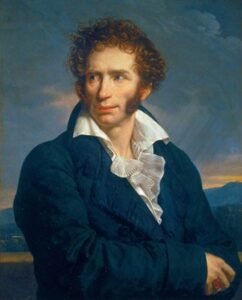 On this day in 1827, writer, revolutionary and poet Ugo Foscolo died at Turnham Green, England, at the age of 49. Born Niccolò Ugo Foscolo on the Ionian island of Zakynthos, Republic of Venice, on 6 February 1778. Perhaps best known for his 1807 long poem Dei Sepolcri, which may be described as an effort to seek refuge in the past from the misery of the present and the darkness of the future.
On this day in 1827, writer, revolutionary and poet Ugo Foscolo died at Turnham Green, England, at the age of 49. Born Niccolò Ugo Foscolo on the Ionian island of Zakynthos, Republic of Venice, on 6 February 1778. Perhaps best known for his 1807 long poem Dei Sepolcri, which may be described as an effort to seek refuge in the past from the misery of the present and the darkness of the future.
From Dei Sepolcri, 1807
All’ombra de’ cipressi e dentro l’urne
confortate di pianto è forse il sonno
della morte men duro? Ove piú il Sole
per me alla terra non-fecondi questa
bella d’erbe famiglia e d’animali,
e quando vaghe di lusinghe innanzi
a me non-danzeran l’ore future,
né da te, dolce amico, udrò piú il verso
e la mesta armonia che lo governa,
né piú nel cor mi parlerà lo spirto
delle vergini Muse e dell’amore,
unico spirto a mia vita raminga,
qual fia ristoro a’ dí perduti un sasso
che distingua le mie dalle infiniteossa che in terra e in mar semina morte?
Lines 1–15 English translation by Foscolo:
Beneath the cypress shade, or sculptured urn
By fond tears watered, is the sleep of death
Less heavy? — When for me the sun no more
Shall shine on earth, to bless with genial beams
This beauteous race of beings animate —
When bright with flattering hues the coming hours
No longer dance before me — and I hear
No more, regarded friend, thy dulcet verse,
Nor the sad gentle harmony it breathes —
When mute within my breast the inspiring voice
Of youthful poesy, and love, sole light
To this my wandering life — what guerdon then
For vanished years will be the marble reared
To mark my dust amid the countless throng
Wherewith the Spoiler strews the land and sea?
 The Final Footprint – Foscolo was entombed in Old Chiswick Cemetery, in Chiswick, England. Forty-four years after his death, on 7 June 1871, his remains were brought to Florence, and with all the pride, pomp and circumstance of a great national mourning, found their final resting-place beside the monuments of Machiavelli and Alfieri, of Michelangelo and Galileo, in the church of Santa Croce, the pantheon of Italian glory he had celebrated in Dei sepolcri. His tomb in the cemetery of St. Nicholas parish church, Chiswick, in West London has recently been restored, it refers to him as the “wearied citizen poet” and incorrectly states his age as 50.
The Final Footprint – Foscolo was entombed in Old Chiswick Cemetery, in Chiswick, England. Forty-four years after his death, on 7 June 1871, his remains were brought to Florence, and with all the pride, pomp and circumstance of a great national mourning, found their final resting-place beside the monuments of Machiavelli and Alfieri, of Michelangelo and Galileo, in the church of Santa Croce, the pantheon of Italian glory he had celebrated in Dei sepolcri. His tomb in the cemetery of St. Nicholas parish church, Chiswick, in West London has recently been restored, it refers to him as the “wearied citizen poet” and incorrectly states his age as 50.
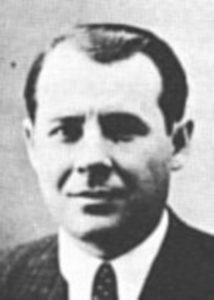 On this day in 1931, Sicilian organized crime figure, early Cosa Nostra boss in the United States, capo di tutti capi, boss of bosses, Salvatore Maranzano died inside his office on the 9th floor of The Helmsley Building in Midtown Manhattan, from multiple gunshot and stab wounds, at the age of 45. Born on 31 July 1886 in Castellammare del Golfo, Sicily. He instigated the Castellammarese War to seize control of the American Mafia operations, and briefly became the Mafia’s “Boss of Bosses”. He was assassinated by a younger faction led by Lucky Luciano, who established a power-sharing arrangement rather than a “boss of bosses” to prevent future wars.
On this day in 1931, Sicilian organized crime figure, early Cosa Nostra boss in the United States, capo di tutti capi, boss of bosses, Salvatore Maranzano died inside his office on the 9th floor of The Helmsley Building in Midtown Manhattan, from multiple gunshot and stab wounds, at the age of 45. Born on 31 July 1886 in Castellammare del Golfo, Sicily. He instigated the Castellammarese War to seize control of the American Mafia operations, and briefly became the Mafia’s “Boss of Bosses”. He was assassinated by a younger faction led by Lucky Luciano, who established a power-sharing arrangement rather than a “boss of bosses” to prevent future wars.
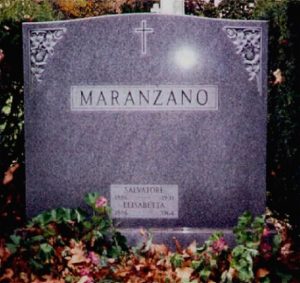 The Final Footprint – Maranzano and his wife Elisabetta (who died in 1964) are buried in Saint John’s Cemetery, Queens, located in New York City. Maranzano plays a small fictionalized role in Mario Puzo’s The Godfather. Maranzano refused Don Vito Corleone’s proposal to share his monopoly on gambling in New York City, in exchange for police and political contacts and expansion into Brooklyn and the Bronx. Maranzano arranged for two of Al Capone’s gunmen to come to New York and finish Corleone. Through his contacts in Chicago, Corleone found out, and sent Luca Brasi to murder the gunmen. With Capone out of the picture, the great mob war of 1933 had begun. Desperate for peace, Maranzano agreed to a sit down in a restaurant in Brooklyn, where he was killed by Salvatore Tessio and his men. Afterwards, Corleone called a meeting to reorganize the American Mafia, something that the real life Maranzano did. Other notable, and infamous, final footprints at Saint John’s include Joe Colombo, Carlo Gambino, John Gotti, Luciano, and Vito Genovese.
The Final Footprint – Maranzano and his wife Elisabetta (who died in 1964) are buried in Saint John’s Cemetery, Queens, located in New York City. Maranzano plays a small fictionalized role in Mario Puzo’s The Godfather. Maranzano refused Don Vito Corleone’s proposal to share his monopoly on gambling in New York City, in exchange for police and political contacts and expansion into Brooklyn and the Bronx. Maranzano arranged for two of Al Capone’s gunmen to come to New York and finish Corleone. Through his contacts in Chicago, Corleone found out, and sent Luca Brasi to murder the gunmen. With Capone out of the picture, the great mob war of 1933 had begun. Desperate for peace, Maranzano agreed to a sit down in a restaurant in Brooklyn, where he was killed by Salvatore Tessio and his men. Afterwards, Corleone called a meeting to reorganize the American Mafia, something that the real life Maranzano did. Other notable, and infamous, final footprints at Saint John’s include Joe Colombo, Carlo Gambino, John Gotti, Luciano, and Vito Genovese.
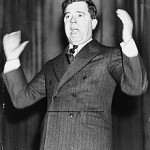 On this day in 1935, the 40th Governor of Louisiana, United States Senator, The Kingfish, Huey Long died from gunshot wounds he sustained at the Louisiana State Capitol building in Baton Rouge during a confrontation with Dr. Carl Weiss. Born Huey Pierce Long, Jr. 0n 30 August 1893 in Winnfield, Louisiana. A Democrat, he was an outspoken populist, partially inspired by sansepolcrista Italian fascism. During his tenure, he commanded large networks of supporters and was willing to take forceful action, influencing claims that he was a political boss. He established the political prominence of the Long political family. Long is best known for his Share Our Wealth program, created in 1934 under the motto “Every Man a King.” It proposed new wealth redistribution measures in the form of a net asset tax on corporations and individuals to curb the poverty and homelessness endemic nationwide during the Great Depression. To stimulate the economy, Long advocated federal spending on public works, schools and colleges, and old age pensions. He was an ardent critic of the policies of the Federal Reserve System. A supporter of Franklin D. Roosevelt in the 1932 presidential election, Long split with Roosevelt in June 1933 to plan his own presidential bid for 1936 in alliance with the influential Catholic priest and radio commentator Charles Coughlin. Under Long’s leadership, hospitals and educational institutions were expanded, a system of charity hospitals was set up that provided health care for the poor, massive highway construction and free bridges brought an end to rural isolationism, and free textbooks for schoolchildren were introduced to tackle illiteracy.
On this day in 1935, the 40th Governor of Louisiana, United States Senator, The Kingfish, Huey Long died from gunshot wounds he sustained at the Louisiana State Capitol building in Baton Rouge during a confrontation with Dr. Carl Weiss. Born Huey Pierce Long, Jr. 0n 30 August 1893 in Winnfield, Louisiana. A Democrat, he was an outspoken populist, partially inspired by sansepolcrista Italian fascism. During his tenure, he commanded large networks of supporters and was willing to take forceful action, influencing claims that he was a political boss. He established the political prominence of the Long political family. Long is best known for his Share Our Wealth program, created in 1934 under the motto “Every Man a King.” It proposed new wealth redistribution measures in the form of a net asset tax on corporations and individuals to curb the poverty and homelessness endemic nationwide during the Great Depression. To stimulate the economy, Long advocated federal spending on public works, schools and colleges, and old age pensions. He was an ardent critic of the policies of the Federal Reserve System. A supporter of Franklin D. Roosevelt in the 1932 presidential election, Long split with Roosevelt in June 1933 to plan his own presidential bid for 1936 in alliance with the influential Catholic priest and radio commentator Charles Coughlin. Under Long’s leadership, hospitals and educational institutions were expanded, a system of charity hospitals was set up that provided health care for the poor, massive highway construction and free bridges brought an end to rural isolationism, and free textbooks for schoolchildren were introduced to tackle illiteracy.
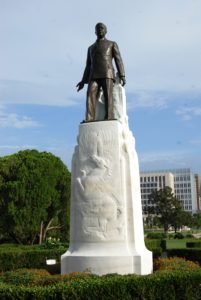 The Final Footprint – Long’s body was dressed in a tuxedo and his open double casket (made of bronze with a copper inner liner covered with a glass lid) was placed in the State Capitol rotunda. An estimated 200,000 people flooded Baton Rouge to witness the event. Tens of thousands of Louisianans crowded in front of the Capitol on September 12, 1935, for the 4 p.m. funeral handled by Merle Welsh of Rabenhorst Funeral Home. Welsh remembered that flowers came from all over the world and extended from the House of Representatives to the Senate chamber. Airline Highway between New Orleans and Baton Rouge was jammed bumper-to-bumper. Newsreel cameras clicked while airplanes circled overhead to record the service for posterity. Long was buried on the grounds of the State Capitol in Baton Rouge. A large bronze statue on top of a marble column marks the site of his grave. A plaque marks the site of the assassination inside the capitol. Also, a bronze statue of Long is located in Statuary Hall of the U. S. Capitol. Long’s assassination put an end to his national movement, but his legacy continued in Louisiana through his wife, Senator Rose McConnell Long, and his son, Senator Russell B. Long. The character Willie Stark from the novel All the King’s Men by Robert Penn Warren appears to be loosely based on Long. This is perhaps my all time favorite book. The book has inspired two movies; the Oscar-winning 1949 version and a 2006 version starring Sean Penn.
The Final Footprint – Long’s body was dressed in a tuxedo and his open double casket (made of bronze with a copper inner liner covered with a glass lid) was placed in the State Capitol rotunda. An estimated 200,000 people flooded Baton Rouge to witness the event. Tens of thousands of Louisianans crowded in front of the Capitol on September 12, 1935, for the 4 p.m. funeral handled by Merle Welsh of Rabenhorst Funeral Home. Welsh remembered that flowers came from all over the world and extended from the House of Representatives to the Senate chamber. Airline Highway between New Orleans and Baton Rouge was jammed bumper-to-bumper. Newsreel cameras clicked while airplanes circled overhead to record the service for posterity. Long was buried on the grounds of the State Capitol in Baton Rouge. A large bronze statue on top of a marble column marks the site of his grave. A plaque marks the site of the assassination inside the capitol. Also, a bronze statue of Long is located in Statuary Hall of the U. S. Capitol. Long’s assassination put an end to his national movement, but his legacy continued in Louisiana through his wife, Senator Rose McConnell Long, and his son, Senator Russell B. Long. The character Willie Stark from the novel All the King’s Men by Robert Penn Warren appears to be loosely based on Long. This is perhaps my all time favorite book. The book has inspired two movies; the Oscar-winning 1949 version and a 2006 version starring Sean Penn.
 On this day in 1971, singer, model, actress Pier Angeli died of a barbiturate overdose at her home in Beverly Hills, aged 39. Born Anna Maria Pierangeli on 19 June 1932 in Cagliari, Sardinia, Italy. She starred in American, British and European films throughout her career. Her American motion picture debut was in the starring role of the film Teresa (1951), for which she won a Golden Globe Award for Young Star of the Year – Actress.
On this day in 1971, singer, model, actress Pier Angeli died of a barbiturate overdose at her home in Beverly Hills, aged 39. Born Anna Maria Pierangeli on 19 June 1932 in Cagliari, Sardinia, Italy. She starred in American, British and European films throughout her career. Her American motion picture debut was in the starring role of the film Teresa (1951), for which she won a Golden Globe Award for Young Star of the Year – Actress.
Angeli was fluent in Italian and English, and could speak and understand spoken French. She was good friends with Debbie Reynolds, Louis Jourdan, and Richard Attenborough.
According to Kirk Douglas’ autobiography The Ragman’s Son, he and Angeli were engaged in the 1950s after meeting on the set of the film The Story of Three Loves (1953). Angeli also had a passionate romantic relationship with James Dean. They met while she was shooting The Silver Chalice (1954) and he was shooting East of Eden (1955), on an adjoining Warner lot. Elia Kazan, the director of East of Eden (1955), remembered hearing Dean and Angeli loudly making love in Dean’s dressing room. Much against her will, she was forced to break it off mainly because her mother was not happy with their relationship as Dean was not Catholic. There were rumors that she and Dean secretly saw each other up until his death; Joe Hyams, in his 1992 biography of Dean, James Dean: Little Boy Lost, claims that he visited Dean just as Angeli, then married to Damone, was leaving his home. An Order for the Solemnization of Marriage pamphlet with the name “Pier” lightly penciled in every place the bride’s name is left blank was found amongst Dean’s personal effects after his death. She would later say that he was the love of her life: “He is the only man I ever loved deeply as a woman should love a man.” Friends of Angeli have said she never fully recovered from his death and that she had nightmares about him up until her own death.
Angeli was married to singer and actor Vic Damone from 1954 to 1958. Singer and actor Dean Martin performed at their wedding. It was reported by several people who attended the wedding that they saw James Dean, claiming Dean watched the wedding from across the road on his motorcycle, even gunning the engine during the ceremony, although Dean later denied doing anything so “dumb”. During their marriage, they appeared as guests on the June 17, 1956 episode of What’s My Line?. She had one son with Vic Damone; their divorce was followed by highly publicized court battles for the custody of their only child, son Perry (1955–2014).
Angeli next married Italian composer Armando Trovajoli in 1962 with whom she had another son, Howard, in 1963. She and Trovajoli separated in 1969.
In the early 1970s she returned to California, after having lived in Britain and Europe throughout the 1960s, and briefly lived with her close friend Debbie Reynolds until she found a little apartment in Beverly Hills.
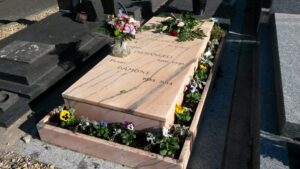 The Final Footprint – On the day of her death, Angeli had been given an injection of Compazine by her doctor. Death due to anaphylaxis has been suggested; however, it is not supported by the findings of her autopsy. Her former lover Kirk Douglas and his wife Anne Buydens were among those who were invited to her funeral. She is interred in the Cimetière des Bulvis in Rueil-Malmaison, Hauts-de-Seine, France.
The Final Footprint – On the day of her death, Angeli had been given an injection of Compazine by her doctor. Death due to anaphylaxis has been suggested; however, it is not supported by the findings of her autopsy. Her former lover Kirk Douglas and his wife Anne Buydens were among those who were invited to her funeral. She is interred in the Cimetière des Bulvis in Rueil-Malmaison, Hauts-de-Seine, France.
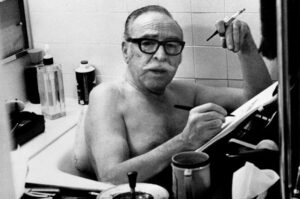 On this day in 1976, screenwriter Dalton Trumbo died in Los Angeles of a heart attack at the age of 70. Born James Dalton Trumbo on December 9, 1905 in Montrose, Colorado. He scripted many award-winning films, including Roman Holiday (1953), Exodus, Spartacus (both 1960), and Thirty Seconds Over Tokyo (1944). One of the Hollywood Ten, he refused to testify before the House Un-American Activities Committee (HUAC) in 1947 during the committee’s investigation of alleged Communist influences in the motion picture industry. Trumbo, the other members of the Hollywood Ten, and hundreds of other professionals in the industry were blacklisted by Hollywood. He was able to continue working clandestinely on major films, writing under pseudonyms or other authors’ names. His uncredited work won two Academy Awards for Best Story: for Roman Holiday (1953), which was presented to a front writer, and for The Brave One (1956), which was awarded to a pseudonym used by Trumbo. When he was given public screen credit for both Exodus and Spartacus in 1960, it marked the beginning of the end of the Hollywood Blacklist for Trumbo and other affected screenwriters. He finally was given full credit by the Writers’ Guild for Roman Holiday in 2011, nearly 60 years after the fact.
On this day in 1976, screenwriter Dalton Trumbo died in Los Angeles of a heart attack at the age of 70. Born James Dalton Trumbo on December 9, 1905 in Montrose, Colorado. He scripted many award-winning films, including Roman Holiday (1953), Exodus, Spartacus (both 1960), and Thirty Seconds Over Tokyo (1944). One of the Hollywood Ten, he refused to testify before the House Un-American Activities Committee (HUAC) in 1947 during the committee’s investigation of alleged Communist influences in the motion picture industry. Trumbo, the other members of the Hollywood Ten, and hundreds of other professionals in the industry were blacklisted by Hollywood. He was able to continue working clandestinely on major films, writing under pseudonyms or other authors’ names. His uncredited work won two Academy Awards for Best Story: for Roman Holiday (1953), which was presented to a front writer, and for The Brave One (1956), which was awarded to a pseudonym used by Trumbo. When he was given public screen credit for both Exodus and Spartacus in 1960, it marked the beginning of the end of the Hollywood Blacklist for Trumbo and other affected screenwriters. He finally was given full credit by the Writers’ Guild for Roman Holiday in 2011, nearly 60 years after the fact.
In 1938, Trumbo married Cleo Fincher, who was born in Fresno, California, on July 17, 1916, and had moved with her divorced mother and her brother and sister to Los Angeles. The Trumbos had three children: Nikola Trumbo (1939), who became a psychotherapist; Christopher Trumbo (1940), a filmmaker and screenwriter who became an expert on the Hollywood blacklist; and Melissa Trumbo (1945), known as Mitzi, a photographer.
Cleo died of natural causes at the age of 93 on October 9, 2009, at the home she shared with Mitzi in Los Altos, California.
The Final Footprint – He donated his body to scientific research.
 On this day in 2005, musician, singer Clarence “Gatemouth” Brown died in Orange, Texas at the apartment of a grandniece, at the age of 81. Born on April 18, 1924 in Vinton, Louisiana. He won a Grammy Award for Best Traditional Blues Album in 1983 for his album, Alright Again!.
On this day in 2005, musician, singer Clarence “Gatemouth” Brown died in Orange, Texas at the apartment of a grandniece, at the age of 81. Born on April 18, 1924 in Vinton, Louisiana. He won a Grammy Award for Best Traditional Blues Album in 1983 for his album, Alright Again!.
Brown was married and divorced three times.
In September 2004, Brown was diagnosed with lung cancer. He already had emphysema and heart disease, and he and his doctors decided to forego treatment for the cancer. This greatly affected his musical career. His home in Slidell, Louisiana, was destroyed by Hurricane Katrina in August 2005, although he had been evacuated to his childhood hometown of Orange, Texas, and lived with his brother before the storm hit.
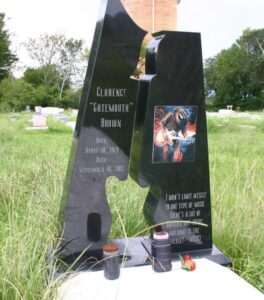 The Final Footprint – Brown is buried in the Hollywood Cemetery in Orange. Flooding caused by Hurricane Ike in September 2008 damaged his grave. His grave has since been refurbished and through the estate funds, a headstone has been erected in his honor. A marker honoring Brown was placed by the Texas Historical Commission next to the flagpole at Hollywood Cemetery.
The Final Footprint – Brown is buried in the Hollywood Cemetery in Orange. Flooding caused by Hurricane Ike in September 2008 damaged his grave. His grave has since been refurbished and through the estate funds, a headstone has been erected in his honor. A marker honoring Brown was placed by the Texas Historical Commission next to the flagpole at Hollywood Cemetery.
#RIP #OTD in 2007 actress (Stage Fright, So Big, Magnificent Obsession, All That Heaven Allows, Johnny Belinda, Falcon Crest) Jane Wyman died in her sleep at her home in Rancho Mirage, aged 90. Forest Lawn Memorial Park, Cathedral City, California
#RIP #OTD in 2011 actor (Charly, Twilight Zone, Three Days of the Condor, Spiderman) Cliff Robertson died in Stony Brook, New York, aged 88. Cremated remains Cedar Lawn Cemetery, East Hampton, New York
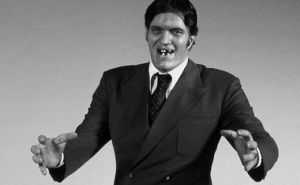 On this day in 2014, actor Richard Kiel died from a heart attack at St. Agnes Medical Center in Fresno, California, at the age of 74. Born Richard Dawson Kiel on September 13, 1939 in Detroit, Michigan. Standing 7 ft 2 in (218 cm) tall, he was perhaps best known for his role as Jaws in the James Bond franchise, portraying the character in The Spy Who Loved Me (1977) and Moonraker (1979). Kiel’s other notable roles include; Mr. Larson in Happy Gilmore (1996), The Longest Yard (1974), Silver Streak (1976), Force 10 from Navarone (1978), Cannonball Run II (1984), Pale Rider (1985) and Tangled (2010).
On this day in 2014, actor Richard Kiel died from a heart attack at St. Agnes Medical Center in Fresno, California, at the age of 74. Born Richard Dawson Kiel on September 13, 1939 in Detroit, Michigan. Standing 7 ft 2 in (218 cm) tall, he was perhaps best known for his role as Jaws in the James Bond franchise, portraying the character in The Spy Who Loved Me (1977) and Moonraker (1979). Kiel’s other notable roles include; Mr. Larson in Happy Gilmore (1996), The Longest Yard (1974), Silver Streak (1976), Force 10 from Navarone (1978), Cannonball Run II (1984), Pale Rider (1985) and Tangled (2010).
Kiel’s first marriage was to Faye Daniels in 1960. They divorced in the early 1970s. He later married Diane Rogers. They had four children and nine grandchildren.
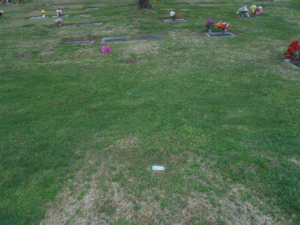 The Final Footprint
The Final Footprint
Kiel is interred in Belmont Memorial Park in Fresno, California.
 On this day in 2020 actress (The Avengers, On Her Majesty’s Secret Service, Game of Thrones) Diana Rigg died from lung cancer at her London home, aged 82. Her roles include Emma Peel in the TV series The Avengers (1965–1968); Countess Teresa di Vicenzo, wife of James Bond, in On Her Majesty’s Secret Service (1969); Olenna Tyrell in Game of Thrones (2013–2017); and the title role in Medea in the West End in 1993 followed by Broadway a year later.
On this day in 2020 actress (The Avengers, On Her Majesty’s Secret Service, Game of Thrones) Diana Rigg died from lung cancer at her London home, aged 82. Her roles include Emma Peel in the TV series The Avengers (1965–1968); Countess Teresa di Vicenzo, wife of James Bond, in On Her Majesty’s Secret Service (1969); Olenna Tyrell in Game of Thrones (2013–2017); and the title role in Medea in the West End in 1993 followed by Broadway a year later.
Rigg made her professional stage debut in 1957 in The Caucasian Chalk Circle and joined the Royal Shakespeare Company in 1959. She made her Broadway debut in Abelard & Heloise in 1971. Her role as Emma Peel made her a sex symbol. For her role in Medea, both in London and New York, she won the 1994 Tony Award for Best Actress in a Play. She was made a CBE in 1988 and a Dame in 1994 for services to drama.
Rigg appeared in numerous TV series and films, playing Helena in A Midsummer Night’s Dream (1968); Lady Holiday in The Great Muppet Caper (1981); and Arlena Marshall in Evil Under the Sun (1982). She won the BAFTA TV Award for Best Actress for the BBC miniseries Mother Love (1989) and an Emmy Award for her role as Mrs. Danvers in an adaptation of Rebecca (1997). Her other television credits include You, Me and the Apocalypse (2015), Detectorists (2015), the Doctor Who episode “The Crimson Horror” (2013) with her daughter Rachael Stirling, and playing Mrs Pumphrey in All Creatures Great and Small (2020). Her final role was in Edgar Wright’s 2021 psychological horror film Last Night in Soho, completed just before her death.
As an Emmy and Tony Award winner, Rigg was an Academy Award away from achieving the Triple Crown of Acting status.
The Final Footprint – Rigg was cremated at Breakspear Crematorium Ruislip, London Borough of Hillingdon, Greater London, England.
#RIP #OTD in 2023 singer-songwriter (I Want You Bad, My Hometown, El Cerrito Place, Good Times) Charlie Robison died after suffering from cardiac arrest and other complications at a San Antonio, Texas, hospital aged 59. Bandera Cemetery, Bandera, Texas
Have you planned yours yet?
Follow TFF on twitter @RIPTFF

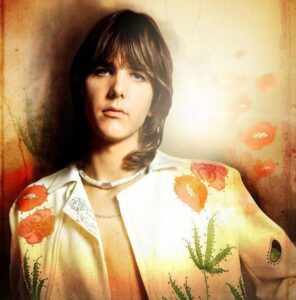 On this day in 1973, singer, songwriter, musician Gram Parsons died in Joshua Tree, California, at the age of 26 from an overdose of morphine and alcohol. Born Ingram Cecil Connor III on 5 November 1946, in Winter Haven, Florida. Parsons is best known for his work within the country music genre; he also popularized what he called “Cosmic American Music”, a hybrid of country, rhythm and blues, soul, folk, and rock. Besides recording as a solo artist, he also worked in several notable bands, including the International Submarine Band, The Byrds, and The Flying Burrito Brothers. His relatively short career is described by Allmusic as “enormously influential” for both country and rock, “blending the two genres to the point that they became indistinguishable from each other.” Parsons apparently developed an interest in country music while attending Harvard University. He founded the International Submarine Band in 1966, and after several months of delay their debut, Safe at Home, was released in 1968, by which time the group had disbanded. Parsons joined The Byrds in early 1968, and played a pivotal role in the making of the seminal Sweetheart of the Rodeo album. After leaving the group in late 1968, Parsons and fellow Byrd Chris Hillman formed The Flying Burrito Brothers in 1969, releasing their debut, The Gilded Palace of Sin, the same year. The album was well received but failed commercially. After a cross-country tour, they recorded Burrito Deluxe. Parsons was fired from the band before its release in early 1970. He soon signed with A&M Records, but after several unproductive sessions he canceled his intended solo debut in early 1971. Parsons moved to France, where he lived for a short period at Villa Nellcôte with his friend Keith Richards of The Rolling Stones. Returning to America, Parsons befriended Emmylou Harris, who assisted him on vocals for his first solo record, GP, released in 1973. Although it received enthusiastic reviews, the release failed to chart; his next album, Grievous Angel met with a similar reception, and peaked at number 195 on Billboard.
On this day in 1973, singer, songwriter, musician Gram Parsons died in Joshua Tree, California, at the age of 26 from an overdose of morphine and alcohol. Born Ingram Cecil Connor III on 5 November 1946, in Winter Haven, Florida. Parsons is best known for his work within the country music genre; he also popularized what he called “Cosmic American Music”, a hybrid of country, rhythm and blues, soul, folk, and rock. Besides recording as a solo artist, he also worked in several notable bands, including the International Submarine Band, The Byrds, and The Flying Burrito Brothers. His relatively short career is described by Allmusic as “enormously influential” for both country and rock, “blending the two genres to the point that they became indistinguishable from each other.” Parsons apparently developed an interest in country music while attending Harvard University. He founded the International Submarine Band in 1966, and after several months of delay their debut, Safe at Home, was released in 1968, by which time the group had disbanded. Parsons joined The Byrds in early 1968, and played a pivotal role in the making of the seminal Sweetheart of the Rodeo album. After leaving the group in late 1968, Parsons and fellow Byrd Chris Hillman formed The Flying Burrito Brothers in 1969, releasing their debut, The Gilded Palace of Sin, the same year. The album was well received but failed commercially. After a cross-country tour, they recorded Burrito Deluxe. Parsons was fired from the band before its release in early 1970. He soon signed with A&M Records, but after several unproductive sessions he canceled his intended solo debut in early 1971. Parsons moved to France, where he lived for a short period at Villa Nellcôte with his friend Keith Richards of The Rolling Stones. Returning to America, Parsons befriended Emmylou Harris, who assisted him on vocals for his first solo record, GP, released in 1973. Although it received enthusiastic reviews, the release failed to chart; his next album, Grievous Angel met with a similar reception, and peaked at number 195 on Billboard. The Final Footprint – Parsons’ body disappeared from the Los Angeles International Airport where it was being readied to be shipped to Louisiana for burial. Prior to his death, Parsons stated that he wanted his body cremated at Joshua Tree and his ashes spread over Cap Rock, a prominent natural feature there; however, Parsons’ stepfather, Robert Parson, arranged for a private ceremony back in New Orleans and neglected to invite any of his friends from the music industry. To fulfill Parsons’ funeral wishes, his friend Phil Kaufman stole his body from the airport and in a borrowed hearse drove it to Joshua Tree. Upon reaching the Cap Rock section of the park, they attempted to cremate Parsons’ corpse by pouring five gallons of gasoline into the open coffin and throwing a lit match inside. What resulted was an enormous fireball. The police gave chase but, as one account puts it, “were encumbered by sobriety,” and the men escaped. The two were arrested several days later. Since there was no law against stealing a dead body, they were only fined $750 for stealing the coffin and were not prosecuted for leaving 35 lbs of his charred remains in the desert.
The Final Footprint – Parsons’ body disappeared from the Los Angeles International Airport where it was being readied to be shipped to Louisiana for burial. Prior to his death, Parsons stated that he wanted his body cremated at Joshua Tree and his ashes spread over Cap Rock, a prominent natural feature there; however, Parsons’ stepfather, Robert Parson, arranged for a private ceremony back in New Orleans and neglected to invite any of his friends from the music industry. To fulfill Parsons’ funeral wishes, his friend Phil Kaufman stole his body from the airport and in a borrowed hearse drove it to Joshua Tree. Upon reaching the Cap Rock section of the park, they attempted to cremate Parsons’ corpse by pouring five gallons of gasoline into the open coffin and throwing a lit match inside. What resulted was an enormous fireball. The police gave chase but, as one account puts it, “were encumbered by sobriety,” and the men escaped. The two were arrested several days later. Since there was no law against stealing a dead body, they were only fined $750 for stealing the coffin and were not prosecuted for leaving 35 lbs of his charred remains in the desert. 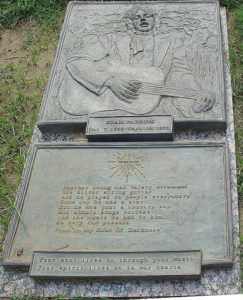 Parsons body was eventually buried in Garden of Memories of Metairie, Louisiana. The site of Parsons’ cremation was marked by a small concrete slab and was presided over by a large rock flake known to rock climbers as The Gram Parsons Memorial Hand Traverse. The slab has since been removed by the U.S. National Park Service, and relocated to the Joshua Tree Inn. There is no monument at Cap Rock noting Parsons’ cremation at the site. Joshua Tree park guides are given the option to tell the story of Parsons’ cremation during tours, but there is no mention of the act in official maps or brochures. Fans regularly assemble simple rock structures and writings on the rock, which the park service sand blasts to remove from time to time.
Parsons body was eventually buried in Garden of Memories of Metairie, Louisiana. The site of Parsons’ cremation was marked by a small concrete slab and was presided over by a large rock flake known to rock climbers as The Gram Parsons Memorial Hand Traverse. The slab has since been removed by the U.S. National Park Service, and relocated to the Joshua Tree Inn. There is no monument at Cap Rock noting Parsons’ cremation at the site. Joshua Tree park guides are given the option to tell the story of Parsons’ cremation during tours, but there is no mention of the act in official maps or brochures. Fans regularly assemble simple rock structures and writings on the rock, which the park service sand blasts to remove from time to time.
 On this day in 1970, musician, singer, songwriter, one of the greatest electric guitar players, member of the Forever 27 Club, Jimi Hendrix died in London in the flat of his girlfriend Monika Dannemann in the Samarkand Hotel, 22 Lansdowne Crescent, Notting Hill, apparently from an accidental overdose of prescription medication, at the age of 27. Born Johnny Allen Hendrix on 27 November 1942 in Seattle, Washington. In 1946 his parents changed his name to James Marshall Hendrix, in honor of his father, James Allen Ross, and his late brother Leon Marshall. Despite a limited mainstream exposure of four years, he is widely considered one of the most influential electric guitarists in the history of popular music and one of the most celebrated musicians of the 20th century. In 1964, he earned a spot in the Isley Brothers’ backing band and later that year he found work with Little Richard, with whom he continued to play through mid-1965. He then joined Curtis Knight and the Squires before moving to England in late 1966. In 1967, Hendrix earned three UK top ten hits with the Jimi Hendrix Experience: “Hey Joe”, “Purple Haze”, and “The Wind Cries Mary”. Later that year, he achieved fame in the US after his performance at the Monterey Pop Festival. The world’s highest paid performer, he headlined the Woodstock Festival in 1969 and the Isle of Wight Festival in 1970. Inspired musically by American rock and roll and electric blues, Hendrix favored overdriven amplifiers with high volume and gain, and was instrumental in developing the previously undesirable technique of guitar amplifier feedback. He helped to popularize the use of a wah-wah pedal in mainstream rock, and pioneered experimentation with stereophonic phasing effects in music recordings. Hendrix was the recipient of several music awards during his lifetime and posthumously; the Jimi Hendrix Experience was inducted into the Rock and Roll Hall of Fame in 1992 and the UK Music Hall of Fame in 2005. Rolling Stone ranked his three non-posthumous studio albums, Are You Experienced, Axis: Bold as Love, and Electric Ladyland among the 100 greatest albums of all time and they ranked Hendrix as the greatest guitarist. Other members of the Forever 27 Club include; Kurt Cobain, Brian Jones, Robert Johnson, Janis Joplin, Jim Morrison, Alan Wilson, Amy Winehouse, and Anton Yelchin.
On this day in 1970, musician, singer, songwriter, one of the greatest electric guitar players, member of the Forever 27 Club, Jimi Hendrix died in London in the flat of his girlfriend Monika Dannemann in the Samarkand Hotel, 22 Lansdowne Crescent, Notting Hill, apparently from an accidental overdose of prescription medication, at the age of 27. Born Johnny Allen Hendrix on 27 November 1942 in Seattle, Washington. In 1946 his parents changed his name to James Marshall Hendrix, in honor of his father, James Allen Ross, and his late brother Leon Marshall. Despite a limited mainstream exposure of four years, he is widely considered one of the most influential electric guitarists in the history of popular music and one of the most celebrated musicians of the 20th century. In 1964, he earned a spot in the Isley Brothers’ backing band and later that year he found work with Little Richard, with whom he continued to play through mid-1965. He then joined Curtis Knight and the Squires before moving to England in late 1966. In 1967, Hendrix earned three UK top ten hits with the Jimi Hendrix Experience: “Hey Joe”, “Purple Haze”, and “The Wind Cries Mary”. Later that year, he achieved fame in the US after his performance at the Monterey Pop Festival. The world’s highest paid performer, he headlined the Woodstock Festival in 1969 and the Isle of Wight Festival in 1970. Inspired musically by American rock and roll and electric blues, Hendrix favored overdriven amplifiers with high volume and gain, and was instrumental in developing the previously undesirable technique of guitar amplifier feedback. He helped to popularize the use of a wah-wah pedal in mainstream rock, and pioneered experimentation with stereophonic phasing effects in music recordings. Hendrix was the recipient of several music awards during his lifetime and posthumously; the Jimi Hendrix Experience was inducted into the Rock and Roll Hall of Fame in 1992 and the UK Music Hall of Fame in 2005. Rolling Stone ranked his three non-posthumous studio albums, Are You Experienced, Axis: Bold as Love, and Electric Ladyland among the 100 greatest albums of all time and they ranked Hendrix as the greatest guitarist. Other members of the Forever 27 Club include; Kurt Cobain, Brian Jones, Robert Johnson, Janis Joplin, Jim Morrison, Alan Wilson, Amy Winehouse, and Anton Yelchin. The Final Footprint – On 29 September, Hendrix’s body was returned to Seattle. After a service at Dunlop Baptist Church on 1 October, he was interred in Greenwood Memorial Park (a
The Final Footprint – On 29 September, Hendrix’s body was returned to Seattle. After a service at Dunlop Baptist Church on 1 October, he was interred in Greenwood Memorial Park (a 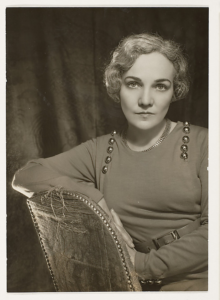 On this day in 1980, journalist, essayist, author, poet and Pulitzer Prize recipient, Katherine Anne Porter died in Silver Spring, Maryland at the age of 90. Born Callie Russell Porter on 15 May 1890 in Indian Creek, Texas. Her 1962 novel Ship of Fools was the best-selling novel in America that year, but her short stories received more critical acclaim. She is known for her penetrating insight. Her work deals with dark themes such as betrayal, death and the origin of human evil. She was married and divorced four times and never had any children.
On this day in 1980, journalist, essayist, author, poet and Pulitzer Prize recipient, Katherine Anne Porter died in Silver Spring, Maryland at the age of 90. Born Callie Russell Porter on 15 May 1890 in Indian Creek, Texas. Her 1962 novel Ship of Fools was the best-selling novel in America that year, but her short stories received more critical acclaim. She is known for her penetrating insight. Her work deals with dark themes such as betrayal, death and the origin of human evil. She was married and divorced four times and never had any children.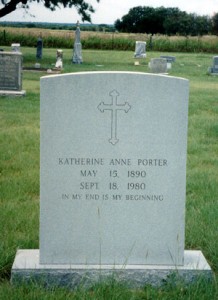 The Final Footprint – Porter was cremated and her ashes were buried next to her mothers in the Indian Creek Cemetery in Indian Creek. Her grave is marked by an upright granite marker. In addition to her name and birth and death dates, the monument inscription reads; IN MY END IS MY BEGINNING. One of my favorite writers, I commemorate her birthday every year by reading some of her short stories. In 1990, Recorded Texas Historic Landmark number 2905 was placed in Brown County, Texas to honor the life and career of Porter. One of my very favorite writers. Each year on her birthday I read some of her short stories.
The Final Footprint – Porter was cremated and her ashes were buried next to her mothers in the Indian Creek Cemetery in Indian Creek. Her grave is marked by an upright granite marker. In addition to her name and birth and death dates, the monument inscription reads; IN MY END IS MY BEGINNING. One of my favorite writers, I commemorate her birthday every year by reading some of her short stories. In 1990, Recorded Texas Historic Landmark number 2905 was placed in Brown County, Texas to honor the life and career of Porter. One of my very favorite writers. Each year on her birthday I read some of her short stories. And on this day in 2020, lawyer and jurist who served as an associate justice of the Supreme Court of the United States from 1993 until her death, Ruth Bader Ginsburg died of pancreatic cancer in Washington DC, at age 87.
And on this day in 2020, lawyer and jurist who served as an associate justice of the Supreme Court of the United States from 1993 until her death, Ruth Bader Ginsburg died of pancreatic cancer in Washington DC, at age 87. The Final Footprint – She died on the eve of Rosh Hashanah, and according to Rabbi Richard Jacobs, “One of the themes of Rosh Hashanah suggest that very righteous people would die at the very end of the year because they were needed until the very end”. After the announcement of her death, thousands of people gathered in front of the Supreme Court building to lay flowers, light candles, and leave messages.
The Final Footprint – She died on the eve of Rosh Hashanah, and according to Rabbi Richard Jacobs, “One of the themes of Rosh Hashanah suggest that very righteous people would die at the very end of the year because they were needed until the very end”. After the announcement of her death, thousands of people gathered in front of the Supreme Court building to lay flowers, light candles, and leave messages.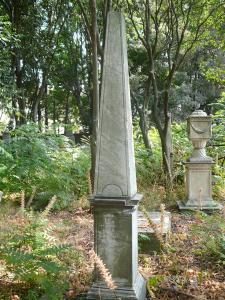 The Final Footprint – He is interred in the English Cimitero in Livorno. There is a monument to his memory beside Renton Primary School, Dunbartonshire, Scotland, on which there is a Latin inscription composed by Samuel Johnson. The area around the monument was improved in 2002, with an explanatory plaque. There is also a plaque to his temporary residence in Edinburgh just off the Royal Mile at the head of St John’s Street. This states that he resided here in the house of his sister, Mrs. Telfer, for the summer of 1766. A second plaque (dating the building at 1758, making it relatively new at that time) states that he “stayed here occasionally”.
The Final Footprint – He is interred in the English Cimitero in Livorno. There is a monument to his memory beside Renton Primary School, Dunbartonshire, Scotland, on which there is a Latin inscription composed by Samuel Johnson. The area around the monument was improved in 2002, with an explanatory plaque. There is also a plaque to his temporary residence in Edinburgh just off the Royal Mile at the head of St John’s Street. This states that he resided here in the house of his sister, Mrs. Telfer, for the summer of 1766. A second plaque (dating the building at 1758, making it relatively new at that time) states that he “stayed here occasionally”.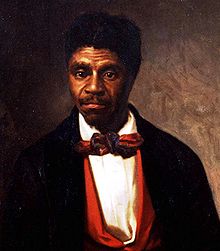 On this day in 1858, African-American former slave, Dred Scott died in St. Louis from tuberculosis at the age of about 59. Born about 1799 in Southampton County, Virginia into slavery. He unsuccessfully sued for his freedom in the Supreme Court case Dred Scott v. Sandford of 1857. He was formally freed by Henry Taylor Blow on 26 May 1857, about three months after the court decision.
On this day in 1858, African-American former slave, Dred Scott died in St. Louis from tuberculosis at the age of about 59. Born about 1799 in Southampton County, Virginia into slavery. He unsuccessfully sued for his freedom in the Supreme Court case Dred Scott v. Sandford of 1857. He was formally freed by Henry Taylor Blow on 26 May 1857, about three months after the court decision.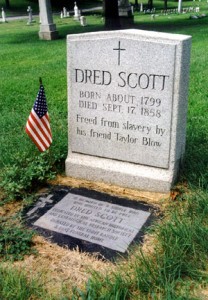
 On this day in 1863, French poet, playwright, and novelist Alfred de Vigny died in Paris at the age of 66. Born in Loches, a commune in the Indre-et-Loire department in central France. He was a major figure in the French Romantic movement. Vigny married Lydia Bunbury, in Pau in 1825. He had an affair with the great actress Marie Dorval. After the death of his mother in 1838 he inherited the property of Maine-Giraud, near Angoulême, where he wrote some of his most famous poems, including La Mort du loup and La Maison du berger. (Apparently Proust regarded La Maison du berger as the greatest French poem of the 19th century.) In 1845, after several unsuccessful attempts to be elected, Vigny became a member of the Académie française. In his later years he spent much time preparing the posthumous collection of poems now known as Les Destinées (though Vigny’s intended title was Poèmes philosophiques) which concludes with Vigny’s final message to the world, L’Esprit pur.
On this day in 1863, French poet, playwright, and novelist Alfred de Vigny died in Paris at the age of 66. Born in Loches, a commune in the Indre-et-Loire department in central France. He was a major figure in the French Romantic movement. Vigny married Lydia Bunbury, in Pau in 1825. He had an affair with the great actress Marie Dorval. After the death of his mother in 1838 he inherited the property of Maine-Giraud, near Angoulême, where he wrote some of his most famous poems, including La Mort du loup and La Maison du berger. (Apparently Proust regarded La Maison du berger as the greatest French poem of the 19th century.) In 1845, after several unsuccessful attempts to be elected, Vigny became a member of the Académie française. In his later years he spent much time preparing the posthumous collection of poems now known as Les Destinées (though Vigny’s intended title was Poèmes philosophiques) which concludes with Vigny’s final message to the world, L’Esprit pur.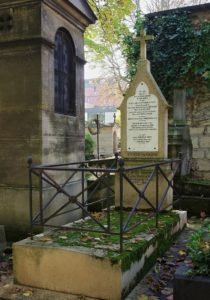 The Final Footprint – Vigny is entombed beside his wife in the Cimetière de Montmartre in Paris. Other notable final footprints at Montmartre include; Hector Berlioz, Dalida, Edgar Degas, Léo Delibes, Alexandre Dumas, fils, Marie Duplessis, Theophile Gautier, Gustave Moreau, Henri Murger, Jacques Offenbach, Francis Picabia, Stendahl, François Truffaut
The Final Footprint – Vigny is entombed beside his wife in the Cimetière de Montmartre in Paris. Other notable final footprints at Montmartre include; Hector Berlioz, Dalida, Edgar Degas, Léo Delibes, Alexandre Dumas, fils, Marie Duplessis, Theophile Gautier, Gustave Moreau, Henri Murger, Jacques Offenbach, Francis Picabia, Stendahl, François Truffaut On this day in 1997 actor, artist, comedian Red Skelton died at the Eisenhower Medical Center in Rancho Mirage, California, at the age of 84. Born Ricard Skelton on July 18, 1913 in Vincennes, Indiana. Perhaps best known for his national radio and television shows between 1937 and 1971, especially as host of the television program The Red Skelton Show. He has stars on the Hollywood Walk of Fame for his work in radio and television, and also appeared in burlesque, vaudeville, films, nightclubs, and casinos, all while he pursued an entirely separate career as an artist.
On this day in 1997 actor, artist, comedian Red Skelton died at the Eisenhower Medical Center in Rancho Mirage, California, at the age of 84. Born Ricard Skelton on July 18, 1913 in Vincennes, Indiana. Perhaps best known for his national radio and television shows between 1937 and 1971, especially as host of the television program The Red Skelton Show. He has stars on the Hollywood Walk of Fame for his work in radio and television, and also appeared in burlesque, vaudeville, films, nightclubs, and casinos, all while he pursued an entirely separate career as an artist.
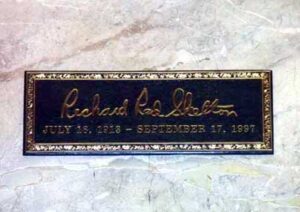 The Final Footprint – Forest Lawn Memorial Park,, Glendale. Great Mausoleum, Memorial Terrace, Sanctuary of Benediction, Distinguished Memorial – Private Family Mausoleum Room #40, Crypt A (left/south side wall; 1st room from corridor entrance; top crypt), alongside his son, Richard Freeman Skelton, Jr., and his second wife, Georgia Maureen Davis Skelton.
The Final Footprint – Forest Lawn Memorial Park,, Glendale. Great Mausoleum, Memorial Terrace, Sanctuary of Benediction, Distinguished Memorial – Private Family Mausoleum Room #40, Crypt A (left/south side wall; 1st room from corridor entrance; top crypt), alongside his son, Richard Freeman Skelton, Jr., and his second wife, Georgia Maureen Davis Skelton.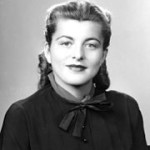 On this day in 2006, socialite, the sixth of nine children of Joseph P. Kennedy, Sr. and Rose Fitzgerald, sister to President John F. Kennedy, Senators Robert F. Kennedy and Edward M. Kennedy, wife of Peter Lawford, Patricia “Pat” Kennedy Lawford died at the age of 82 in her Manhattan home from pneumonia. Born on 6 May 1924 in Brookline, Massachusetts.
On this day in 2006, socialite, the sixth of nine children of Joseph P. Kennedy, Sr. and Rose Fitzgerald, sister to President John F. Kennedy, Senators Robert F. Kennedy and Edward M. Kennedy, wife of Peter Lawford, Patricia “Pat” Kennedy Lawford died at the age of 82 in her Manhattan home from pneumonia. Born on 6 May 1924 in Brookline, Massachusetts.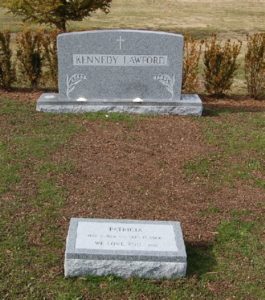 The Final Footprint – She was survived by her four children and 10 grandchildren, as well as, at the time, her sisters Eunice and Jean, and her brother Edward. She was buried in Southampton Cemetery in Southampton, New York.
The Final Footprint – She was survived by her four children and 10 grandchildren, as well as, at the time, her sisters Eunice and Jean, and her brother Edward. She was buried in Southampton Cemetery in Southampton, New York.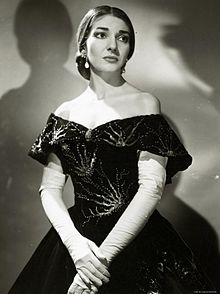
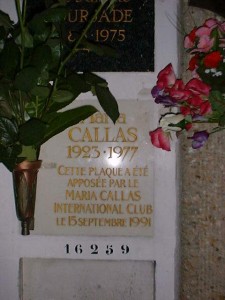 The Final Footprint – Callas was cremated and her ashes were placed in a niche in the cemetery of Pere Lachaise in Paris until 1979 when the ashes were removed and scattered over the Aegean Sea off the coast of Greece in accordance with her wishes. A niche plaque remains at Pere Lachaise to memorialize Callas. Père Lachaise is the largest cemetery in Paris and one of the most visited cemeteries in the world. Other notable Final Footprints at Père Lachaise include; Guillaume Apollinaire, Honoré de Balzac, Georges Bizet, Jean-Dominique Bauby, Frédéric Chopin, Colette, Auguste Comte, Jean-Baptiste-Camille Corot, Max Ernst, Marcel Marceau, Molière, Jim Morrison, Édith Piaf, Camille Pissarro, Marcel Proust, Sully Prudhomme, Gioachino Rossini, Georges-Pierre Seurat, Gertrude Stein, Dorothea Tanning,Alice B. Toklas, Oscar Wilde, and Richard Wright.
The Final Footprint – Callas was cremated and her ashes were placed in a niche in the cemetery of Pere Lachaise in Paris until 1979 when the ashes were removed and scattered over the Aegean Sea off the coast of Greece in accordance with her wishes. A niche plaque remains at Pere Lachaise to memorialize Callas. Père Lachaise is the largest cemetery in Paris and one of the most visited cemeteries in the world. Other notable Final Footprints at Père Lachaise include; Guillaume Apollinaire, Honoré de Balzac, Georges Bizet, Jean-Dominique Bauby, Frédéric Chopin, Colette, Auguste Comte, Jean-Baptiste-Camille Corot, Max Ernst, Marcel Marceau, Molière, Jim Morrison, Édith Piaf, Camille Pissarro, Marcel Proust, Sully Prudhomme, Gioachino Rossini, Georges-Pierre Seurat, Gertrude Stein, Dorothea Tanning,Alice B. Toklas, Oscar Wilde, and Richard Wright.

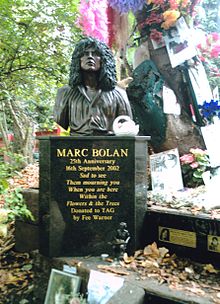
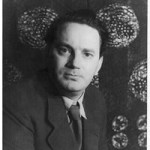 On this day in 1938, novelist Thomas Wolfe died from miliary tuberculosis of the brain at Johns Hopkins Hospital in Baltimore at the age of 37. Born Thomas Clayton Wolfe on 3 October 1900 in Asheville, North Carolina. Haled as either a genius or merely a writer of bad prose. Wolfe wrote four lengthy novels (Look Homeward, Angel; Of Time and the River; You Can’t Go Home Again; The Web and the Rock), plus many short stories, dramatic works and novellas. He is known for mixing highly original, poetic, rhapsodic, and impressionistic prose with autobiographical writing. His books, written and published from the 1920s to the 1940s, vividly reflect on American culture and mores of the period, albeit filtered through Wolfe’s sensitive, sophisticated and hyper-analytical perspective. He became very famous during his own lifetime. After Wolfe’s death, his chief contemporary William Faulkner reportedly said that Wolfe may have had the best talent of their generation. He remains one of the most important writers in modern American literature, as he was one of the first masters of autobiographical fiction. In my opinion, he is North Carolina’s most famous writer.
On this day in 1938, novelist Thomas Wolfe died from miliary tuberculosis of the brain at Johns Hopkins Hospital in Baltimore at the age of 37. Born Thomas Clayton Wolfe on 3 October 1900 in Asheville, North Carolina. Haled as either a genius or merely a writer of bad prose. Wolfe wrote four lengthy novels (Look Homeward, Angel; Of Time and the River; You Can’t Go Home Again; The Web and the Rock), plus many short stories, dramatic works and novellas. He is known for mixing highly original, poetic, rhapsodic, and impressionistic prose with autobiographical writing. His books, written and published from the 1920s to the 1940s, vividly reflect on American culture and mores of the period, albeit filtered through Wolfe’s sensitive, sophisticated and hyper-analytical perspective. He became very famous during his own lifetime. After Wolfe’s death, his chief contemporary William Faulkner reportedly said that Wolfe may have had the best talent of their generation. He remains one of the most important writers in modern American literature, as he was one of the first masters of autobiographical fiction. In my opinion, he is North Carolina’s most famous writer.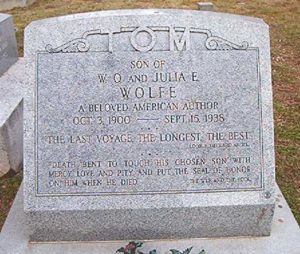 The Final Footprint – Wolfe is buried in Riverside Cemetery in Asheville. His grave is marked by an upright slanted granite monument. In addition to the birth and death dates the monument is inscribed: TOM, SON OF W. O. AND JULIA E. WOLFE, A BELOVED AMERICAN AUTHOR, “THE LAST VOYAGE, THE LONGEST, THE BEST” LOOK HOMEWARD ANGEL, “DEATH BENT TO TOUCH HIS CHOSEN SON WITH MERCY, LOVE AND PITY AND PUT THE SEAL OF HONOR ON HIM WHEN HE DIED” THE WEB AND THE ROCK. The Thomas Wolfe Society was established in the late 1970s to promote appreciation and study of the works of this famous American author. The Society meets annually in May at locations in the U.S. or Europe visited by Wolfe. Recent conferences have been held in Greenville, South Carolina, Paris, France, and Saint Louis, Missouri. The Society issues an annual publication of Wolfe-related materials, as well as its signature journal, The Thomas Wolfe Review, featuring scholarly articles, belles lettres, and reviews. The Society also awards prizes for literary scholarship on Wolfe.
The Final Footprint – Wolfe is buried in Riverside Cemetery in Asheville. His grave is marked by an upright slanted granite monument. In addition to the birth and death dates the monument is inscribed: TOM, SON OF W. O. AND JULIA E. WOLFE, A BELOVED AMERICAN AUTHOR, “THE LAST VOYAGE, THE LONGEST, THE BEST” LOOK HOMEWARD ANGEL, “DEATH BENT TO TOUCH HIS CHOSEN SON WITH MERCY, LOVE AND PITY AND PUT THE SEAL OF HONOR ON HIM WHEN HE DIED” THE WEB AND THE ROCK. The Thomas Wolfe Society was established in the late 1970s to promote appreciation and study of the works of this famous American author. The Society meets annually in May at locations in the U.S. or Europe visited by Wolfe. Recent conferences have been held in Greenville, South Carolina, Paris, France, and Saint Louis, Missouri. The Society issues an annual publication of Wolfe-related materials, as well as its signature journal, The Thomas Wolfe Review, featuring scholarly articles, belles lettres, and reviews. The Society also awards prizes for literary scholarship on Wolfe.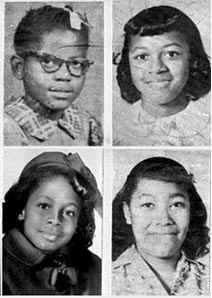 On this day in 1963, Addie Mae Collins (14), Cynthia Wesley (14), Carole Robertson (14), and Carol Denise McNair (11) were murdered when a bomb exploded under the steps of the 16th Street Baptist Church in Birmingham, Alabama. The white supremacist terrorist bombing was carried out by our members of a local Ku Klux Klan chapter.
On this day in 1963, Addie Mae Collins (14), Cynthia Wesley (14), Carole Robertson (14), and Carol Denise McNair (11) were murdered when a bomb exploded under the steps of the 16th Street Baptist Church in Birmingham, Alabama. The white supremacist terrorist bombing was carried out by our members of a local Ku Klux Klan chapter.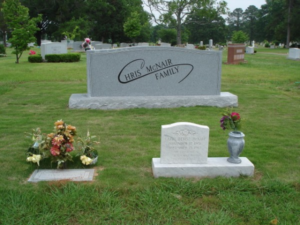
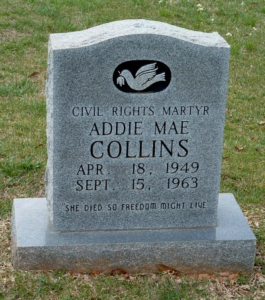
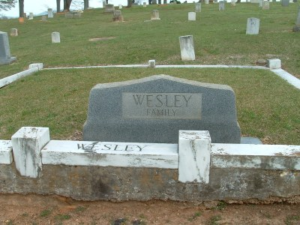
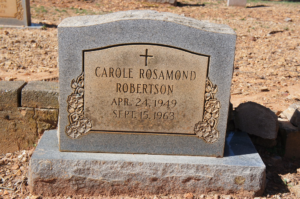
 On this day in 1989, poet, novelist, and literary critic and was one of the founders of New Criticism, Robert Penn Warren died at the age of 84 in Stratton, Vermont of complications from bone cancer. Born on 24 April 1905 in Guthrie, Kentucky. Warren was a charter member of the Fellowship of Southern Writers. He founded the influential literary journal The Southern Review with Cleanth Brooks in 1935. He received the 1947 Pulitzer Prize for the Novel for his novel All the King’s Men (1946) and the Pulitzer Prize for Poetry in 1958 and 1979. He is the only person to have won Pulitzer Prizes for both fiction and poetry.
On this day in 1989, poet, novelist, and literary critic and was one of the founders of New Criticism, Robert Penn Warren died at the age of 84 in Stratton, Vermont of complications from bone cancer. Born on 24 April 1905 in Guthrie, Kentucky. Warren was a charter member of the Fellowship of Southern Writers. He founded the influential literary journal The Southern Review with Cleanth Brooks in 1935. He received the 1947 Pulitzer Prize for the Novel for his novel All the King’s Men (1946) and the Pulitzer Prize for Poetry in 1958 and 1979. He is the only person to have won Pulitzer Prizes for both fiction and poetry.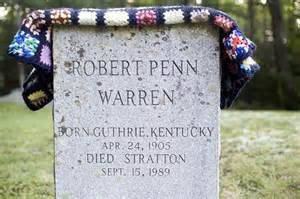 The Final Footprint – Warren is interred in Willis Cemetery in Stratton, Vermont, and, at his request, a memorial marker is situated in the Warren family gravesite in Guthrie, Kentucky. Warren is one of my favorite writers. Each year on his birthday I read some of his short stories and poems.
The Final Footprint – Warren is interred in Willis Cemetery in Stratton, Vermont, and, at his request, a memorial marker is situated in the Warren family gravesite in Guthrie, Kentucky. Warren is one of my favorite writers. Each year on his birthday I read some of his short stories and poems. On this day in 2017, United States Navy veteran, actor, musician and singer Harry Dean Stanton died at the Cedars-Sinai Medical Center in Los Angeles, California, at the age of 91. Born July 14, 1926 in West Irvine, Kentucky.
On this day in 2017, United States Navy veteran, actor, musician and singer Harry Dean Stanton died at the Cedars-Sinai Medical Center in Los Angeles, California, at the age of 91. Born July 14, 1926 in West Irvine, Kentucky. And on this day in 2019 singer, songwriter, musician and record producer, primary co-lead vocalist, rhythm guitarist, songwriter, and frontman for the rock band the Cars, Ric Ocasek died from natural causes at his New York City townhouse, aged 75. Born Richard Theodore Otcasek on March 23, 1944 in Baltimore. In addition to his work with the Cars, Ocasek recorded seven solo albums, and his song “Emotion in Motion” was a top 20 hit in the United States in 1986. In 2018, Ocasek was inducted into the Rock and Roll Hall of Fame as a member of the Cars.
And on this day in 2019 singer, songwriter, musician and record producer, primary co-lead vocalist, rhythm guitarist, songwriter, and frontman for the rock band the Cars, Ric Ocasek died from natural causes at his New York City townhouse, aged 75. Born Richard Theodore Otcasek on March 23, 1944 in Baltimore. In addition to his work with the Cars, Ocasek recorded seven solo albums, and his song “Emotion in Motion” was a top 20 hit in the United States in 1986. In 2018, Ocasek was inducted into the Rock and Roll Hall of Fame as a member of the Cars.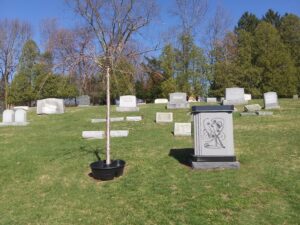
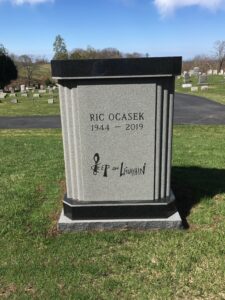 The Final Footprint – Ocasek was found dead Porizkova. He had been recovering from surgery. Nine Partners Cemetery, Millbrook, New York.
The Final Footprint – Ocasek was found dead Porizkova. He had been recovering from surgery. Nine Partners Cemetery, Millbrook, New York.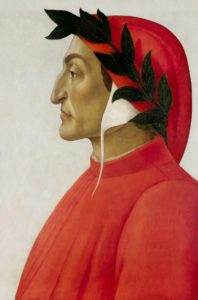 On this day in 1321, poet Dante Alighieri died in Ravenna at the age of c. 56. Born Durante degli Alighieri c. 1265 in Florence, Italy. A major poet of the Late Middle Ages, his Divine Comedy, originally called
On this day in 1321, poet Dante Alighieri died in Ravenna at the age of c. 56. Born Durante degli Alighieri c. 1265 in Florence, Italy. A major poet of the Late Middle Ages, his Divine Comedy, originally called 






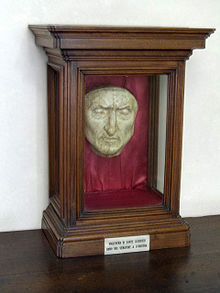

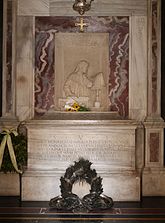



 On this day in 1715, French Benedictine monk Dom Pérignon died at the abbey of Hautvillers near the town of Epernay at the approximate age of 77. Born Pierre Pérignon c. 1638 in the town of Saint-Menehould in the Champagne region of northern France. Dom Pierre made important contributions to the production and quality of Champagne wine in an era when the region’s wines were predominantly still and red. Popular myths frequently, but erroneously, credit him with the invention of sparkling Champagne, which didn’t become the dominant style of Champagne until the mid-19th century. The famous champagne Dom Pérignon, the prestige cuvée of Moët & Chandon, is named after him.
On this day in 1715, French Benedictine monk Dom Pérignon died at the abbey of Hautvillers near the town of Epernay at the approximate age of 77. Born Pierre Pérignon c. 1638 in the town of Saint-Menehould in the Champagne region of northern France. Dom Pierre made important contributions to the production and quality of Champagne wine in an era when the region’s wines were predominantly still and red. Popular myths frequently, but erroneously, credit him with the invention of sparkling Champagne, which didn’t become the dominant style of Champagne until the mid-19th century. The famous champagne Dom Pérignon, the prestige cuvée of Moët & Chandon, is named after him.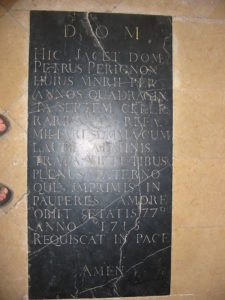 The Final Footprint – Dom Pierre was buried in a section of the abbey cemetery traditionally reserved only for abbots.
The Final Footprint – Dom Pierre was buried in a section of the abbey cemetery traditionally reserved only for abbots.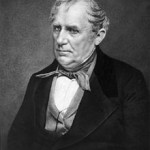 On this day in 1851, writer James Fenimore Cooper died the day before his 62nd birthday from dropsy in Cooperstown, New York. Born in Burlington, New Jersey on 15 September 1789. His historical romances of frontier and Indian life in the early American days created a unique form of American literature. He lived most of his life in Cooperstown, which was established by his father William. He attended Yale University for three years, where he was a member of the Linonian Society, but was expelled for misbehavior. Before embarking on his career as a writer he served in the U.S. Navy as a Midshipman which greatly influenced many of his novels and other writings. He is best remembered as a novelist who wrote numerous sea-stories and the historical novels known as the Leatherstocking Tales. Among his most famous works is the Romantic novel The Last of the Mohicans (1826), often regarded as his masterpiece.
On this day in 1851, writer James Fenimore Cooper died the day before his 62nd birthday from dropsy in Cooperstown, New York. Born in Burlington, New Jersey on 15 September 1789. His historical romances of frontier and Indian life in the early American days created a unique form of American literature. He lived most of his life in Cooperstown, which was established by his father William. He attended Yale University for three years, where he was a member of the Linonian Society, but was expelled for misbehavior. Before embarking on his career as a writer he served in the U.S. Navy as a Midshipman which greatly influenced many of his novels and other writings. He is best remembered as a novelist who wrote numerous sea-stories and the historical novels known as the Leatherstocking Tales. Among his most famous works is the Romantic novel The Last of the Mohicans (1826), often regarded as his masterpiece.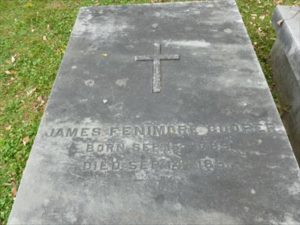 The Final Footprint – Cooper’s interment was in Christ Episcopal Churchyard, where his father, was buried. Cooper’s wife Susan survived her husband only by a few months and was buried by his side at Cooperstown. Several well-known writers, politicians, and other public figures honored Cooper’s memory with a dinner in February 1852; Washington Irving served as a co-chairman for the event, along with William Cullen Bryant and Daniel Webster. The protagonist of Cooper’s Leatherstocking Tales, is Nathaniel “Natty” Bumppo, whose other nickname is Hawkeye. The character of Hawkeye Pierce from M*A*S*H takes his nickname from Bumppo. In both the original book and the TV series it is stated that The Last of the Mohicans is the only book Pierce’s father had ever read. Bumppo is portrayed in the 1992 film version of The Last of the Mohicans by Daniel Day-Lewis. The film also starred Madeleine Stowe and Wes Studi. The soundtrack for the film features music by Trevor Jones and Randy Edelman, and the song “I Will Find You” by Clannad. The main theme of the film is taken from the tune “The Gael” by Scottish singer-songwriter Dougie MacLean. Released on September 25, 1992, in the United States, The Last of the Mohicans was met with nearly-universal praise from critics as well as being commercially successful during its box-office run.
The Final Footprint – Cooper’s interment was in Christ Episcopal Churchyard, where his father, was buried. Cooper’s wife Susan survived her husband only by a few months and was buried by his side at Cooperstown. Several well-known writers, politicians, and other public figures honored Cooper’s memory with a dinner in February 1852; Washington Irving served as a co-chairman for the event, along with William Cullen Bryant and Daniel Webster. The protagonist of Cooper’s Leatherstocking Tales, is Nathaniel “Natty” Bumppo, whose other nickname is Hawkeye. The character of Hawkeye Pierce from M*A*S*H takes his nickname from Bumppo. In both the original book and the TV series it is stated that The Last of the Mohicans is the only book Pierce’s father had ever read. Bumppo is portrayed in the 1992 film version of The Last of the Mohicans by Daniel Day-Lewis. The film also starred Madeleine Stowe and Wes Studi. The soundtrack for the film features music by Trevor Jones and Randy Edelman, and the song “I Will Find You” by Clannad. The main theme of the film is taken from the tune “The Gael” by Scottish singer-songwriter Dougie MacLean. Released on September 25, 1992, in the United States, The Last of the Mohicans was met with nearly-universal praise from critics as well as being commercially successful during its box-office run. On this day in 1927 dancer Isadora Duncan died when her scarf became entangled in the wheel and axle of the car in which she was travelling in Nice, France, aged 50. Born Angela Isadora Duncan on May 26, 1877 or May 27, 1878, in San Francisco. She performed to great acclaim throughout Europe and the US. Duncan lived and danced in Western Europe, the US and the Soviet Union from the age of 22 until her death.
On this day in 1927 dancer Isadora Duncan died when her scarf became entangled in the wheel and axle of the car in which she was travelling in Nice, France, aged 50. Born Angela Isadora Duncan on May 26, 1877 or May 27, 1878, in San Francisco. She performed to great acclaim throughout Europe and the US. Duncan lived and danced in Western Europe, the US and the Soviet Union from the age of 22 until her death. 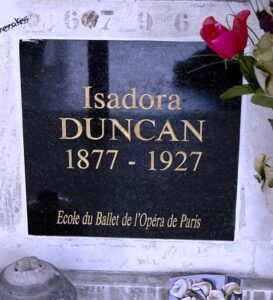 The Final Footprint – Duncan was a passenger in an Amilcar CGSS automobile owned by Benoît Falchetto [fr], a French-Italian mechanic. She wore a long, flowing, hand-painted silk scarf, created by the Russian-born artist Roman Chatov, a gift from her friend Mary Desti. Desti, who saw Duncan off, had asked her to wear a cape in the open-air vehicle because of the cold weather, but she would agree to wear only the scarf. As they departed, she reportedly said to Desti and some companions, “Adieu, mes amis. Je vais à la gloire !” (“Farewell, my friends. I go to glory!”); but according to the American novelist Glenway Wescott, Desti later told him that Duncan’s actual parting words were, “Je vais à l’amour” (“I am off to love”). Desti considered this embarrassing, as it suggested that she and Falchetto were going to her hotel for a tryst.
The Final Footprint – Duncan was a passenger in an Amilcar CGSS automobile owned by Benoît Falchetto [fr], a French-Italian mechanic. She wore a long, flowing, hand-painted silk scarf, created by the Russian-born artist Roman Chatov, a gift from her friend Mary Desti. Desti, who saw Duncan off, had asked her to wear a cape in the open-air vehicle because of the cold weather, but she would agree to wear only the scarf. As they departed, she reportedly said to Desti and some companions, “Adieu, mes amis. Je vais à la gloire !” (“Farewell, my friends. I go to glory!”); but according to the American novelist Glenway Wescott, Desti later told him that Duncan’s actual parting words were, “Je vais à l’amour” (“I am off to love”). Desti considered this embarrassing, as it suggested that she and Falchetto were going to her hotel for a tryst. On this day in 1982, Academy Award-winning actress and Princess of Monaco, Grace Kelly died from a cerebral hemorrage after a car wreck in France near Monaco at the age of 52. Born Grace Patricia Kelly on 12 November 1929 in Philadelphia, Pennsylvania.
On this day in 1982, Academy Award-winning actress and Princess of Monaco, Grace Kelly died from a cerebral hemorrage after a car wreck in France near Monaco at the age of 52. Born Grace Patricia Kelly on 12 November 1929 in Philadelphia, Pennsylvania.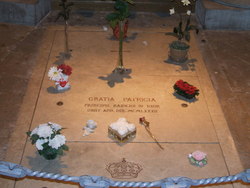 The Final Footprint – Kelly was entombed in the Grimaldi family vault in the Cathedral of Saint Nicholas in Monte Carlo. Diana, Princess of Wales attended her funeral representing the British royal family. Prince Rainier, who did not remarry, was buried alongside her following his death in 2005.
The Final Footprint – Kelly was entombed in the Grimaldi family vault in the Cathedral of Saint Nicholas in Monte Carlo. Diana, Princess of Wales attended her funeral representing the British royal family. Prince Rainier, who did not remarry, was buried alongside her following his death in 2005.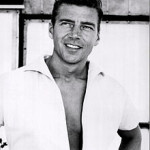
 On this day in 2009, actor, dancer, singer and songwriter Patrick Swayze died from pancreatic cancer at the age of 57 with his family at his side in Los Angeles. Born Patrick Wayne Swayze on 18 August 1952 in Houston.
On this day in 2009, actor, dancer, singer and songwriter Patrick Swayze died from pancreatic cancer at the age of 57 with his family at his side in Los Angeles. Born Patrick Wayne Swayze on 18 August 1952 in Houston. And on this day in 2021, stand-up comedian, actor, writer Norm Macdonald died of leukemia at the City of Hope National Medical Center in Duarte, California, aged 61. Born Norman Gene Macdonald on October 17, 1959 in Quebec City, Canada. His stand-up style was characterized by a slow, almost stuttering deadpan delivery and the use of folksy, old-fashioned turns of phrase. He appeared in many films and was a regular guest on late-night talk shows, where he became best known for telling shaggy dog stories.
And on this day in 2021, stand-up comedian, actor, writer Norm Macdonald died of leukemia at the City of Hope National Medical Center in Duarte, California, aged 61. Born Norman Gene Macdonald on October 17, 1959 in Quebec City, Canada. His stand-up style was characterized by a slow, almost stuttering deadpan delivery and the use of folksy, old-fashioned turns of phrase. He appeared in many films and was a regular guest on late-night talk shows, where he became best known for telling shaggy dog stories. On this day in 1592, French essayist, one of the most influential writers of the French Renaissance, the father of Modern Skepticism, Michel de Montaigne died of quinsy at the age of 59, at his family estate Château de Montaigne. Remaining in possession of all his other faculties, he requested mass, and died during the celebration of that mass. Born Michel Eyquem de Montaigne on 28 February 1533 in the Aquitaine region of France, on the family estate Château de Montaigne, in a town now called Saint-Michel-de-Montaigne, not far from Bordeaux. In my opinion, one of the most influential writers of the French Renaissance, known for popularizing the essay as a literary genre, and commonly thought of as the father of modern skepticism. He became famous for his effortless ability to merge serious intellectual exercises with casual anecdotes and autobiography. His massive volume Essais (translated literally as “Attempts” or “Trials”) contains, to this day, some of the most widely influential essays ever written. In his own time, Montaigne was admired more as a statesman than as an author. The tendency in his essays to digress into anecdotes and personal ruminations was seen as detrimental to proper style rather than as an innovation, and his declaration that, ‘I am myself the matter of my book‘, was viewed by his contemporaries as self-indulgent. In time, however, Montaigne would be recognized as embodying, perhaps better than any other author of his time, the spirit of freely entertaining doubt which began to emerge at that time. Perhaps most famously known for his skeptical remark, ‘Que sçay-je?’ (‘What do I know?’ in Middle French; modern French Que sais-je?). Remarkably modern even to readers today, Montaigne’s attempt to examine the world through the lens of the only thing he can depend on implicitly, his own judgment, makes him more accessible to modern readers than any other author of the Renaissance. Much of modern literary non-fiction has found inspiration in Montaigne and writers of all kinds continue to read him for his masterful balance of intellectual knowledge and personal story-telling.
On this day in 1592, French essayist, one of the most influential writers of the French Renaissance, the father of Modern Skepticism, Michel de Montaigne died of quinsy at the age of 59, at his family estate Château de Montaigne. Remaining in possession of all his other faculties, he requested mass, and died during the celebration of that mass. Born Michel Eyquem de Montaigne on 28 February 1533 in the Aquitaine region of France, on the family estate Château de Montaigne, in a town now called Saint-Michel-de-Montaigne, not far from Bordeaux. In my opinion, one of the most influential writers of the French Renaissance, known for popularizing the essay as a literary genre, and commonly thought of as the father of modern skepticism. He became famous for his effortless ability to merge serious intellectual exercises with casual anecdotes and autobiography. His massive volume Essais (translated literally as “Attempts” or “Trials”) contains, to this day, some of the most widely influential essays ever written. In his own time, Montaigne was admired more as a statesman than as an author. The tendency in his essays to digress into anecdotes and personal ruminations was seen as detrimental to proper style rather than as an innovation, and his declaration that, ‘I am myself the matter of my book‘, was viewed by his contemporaries as self-indulgent. In time, however, Montaigne would be recognized as embodying, perhaps better than any other author of his time, the spirit of freely entertaining doubt which began to emerge at that time. Perhaps most famously known for his skeptical remark, ‘Que sçay-je?’ (‘What do I know?’ in Middle French; modern French Que sais-je?). Remarkably modern even to readers today, Montaigne’s attempt to examine the world through the lens of the only thing he can depend on implicitly, his own judgment, makes him more accessible to modern readers than any other author of the Renaissance. Much of modern literary non-fiction has found inspiration in Montaigne and writers of all kinds continue to read him for his masterful balance of intellectual knowledge and personal story-telling.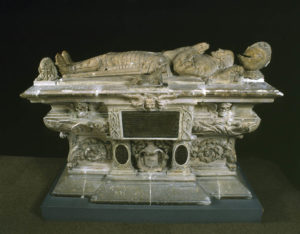
 On this day in 1894, French Romantic composer and pianist Emmanuel Chabrier died in Paris at the age of 53. Born Alexis-Emmanuel Chabrier on 18 January 1841 in Ambert (Puy-de-Dôme), a town in the Auvergne region of central France. Although known primarily for two of his orchestral works, España and Joyeuse marche, he left an important corpus of operas (including the increasingly popular L’étoile), songs, and piano music as well.
On this day in 1894, French Romantic composer and pianist Emmanuel Chabrier died in Paris at the age of 53. Born Alexis-Emmanuel Chabrier on 18 January 1841 in Ambert (Puy-de-Dôme), a town in the Auvergne region of central France. Although known primarily for two of his orchestral works, España and Joyeuse marche, he left an important corpus of operas (including the increasingly popular L’étoile), songs, and piano music as well. The Final Footprint – Although he had asked to be entombed near the tomb of Eduard Manet in the Passy Cemetery, he was laid to rest in the Cimetière de Montparnasse in Paris. Other notable Final Footprints at Montparnasse include; Charles Baudelaire, Simone de Beauvoir, Samuel Beckett, Alfred Dreyfus, Marguerite Duras, Henri Fantin-Latour, César Franck, André Lhote, Guy de Maupassant, Adah Isaacs Menken, Man Ray, Camille Saint-Saëns, Jean-Paul Sartre, Jean Seberg, and Susan Sontag.
The Final Footprint – Although he had asked to be entombed near the tomb of Eduard Manet in the Passy Cemetery, he was laid to rest in the Cimetière de Montparnasse in Paris. Other notable Final Footprints at Montparnasse include; Charles Baudelaire, Simone de Beauvoir, Samuel Beckett, Alfred Dreyfus, Marguerite Duras, Henri Fantin-Latour, César Franck, André Lhote, Guy de Maupassant, Adah Isaacs Menken, Man Ray, Camille Saint-Saëns, Jean-Paul Sartre, Jean Seberg, and Susan Sontag. On this day in 2006, the 45th Governor of Texas, Ann Richards, died at the age of 73 from esophageal cancer at her home in Austin, surrounded by her family. Born Dorothy Ann Willis on 1 September 1933 in Lakeview, Texas. She was governor for one term from 1991 to 1995.
On this day in 2006, the 45th Governor of Texas, Ann Richards, died at the age of 73 from esophageal cancer at her home in Austin, surrounded by her family. Born Dorothy Ann Willis on 1 September 1933 in Lakeview, Texas. She was governor for one term from 1991 to 1995.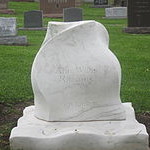 The Final Footprint – Richards is buried at Texas State Cemetery in Austin. Her grave is marked by an upright white marble monument. On the front it says: Ann Willis Richards Governor. On the back is an excerpt from her inaugural address delivered 15 January 1991: Today we have a vision of a Texas where opportunity knows no race, no gender, no color – a glimpse of what can happen in government if we simply open the doors and let the people in. Other notable final footprints at Texas State Cemetery include; Stephen F. Austin, John B. and Nellie Connally, J. Frank Dobie, Barbara Jordan, Tom Landry (cenotaph), James A. Michener (cenotaph), Edwin “Bud” Shrake, Big Foot Wallace, and Walter Prescott Webb.
The Final Footprint – Richards is buried at Texas State Cemetery in Austin. Her grave is marked by an upright white marble monument. On the front it says: Ann Willis Richards Governor. On the back is an excerpt from her inaugural address delivered 15 January 1991: Today we have a vision of a Texas where opportunity knows no race, no gender, no color – a glimpse of what can happen in government if we simply open the doors and let the people in. Other notable final footprints at Texas State Cemetery include; Stephen F. Austin, John B. and Nellie Connally, J. Frank Dobie, Barbara Jordan, Tom Landry (cenotaph), James A. Michener (cenotaph), Edwin “Bud” Shrake, Big Foot Wallace, and Walter Prescott Webb. On this day in 2019, singer and songwriter Eddie Money died from complications of esophageal cancer in Los Angeles at age 70. Born Edward Joseph Mahoney on March 21, 1949 in Brooklyn. Perhaps best known for the songs “Baby Hold On”, “Two Tickets to Paradise”, “Think I’m in Love”, “Shakin'”, “Take Me Home Tonight”, “I Wanna Go Back”, “Walk on Water”, and “The Love in Your Eyes”.
On this day in 2019, singer and songwriter Eddie Money died from complications of esophageal cancer in Los Angeles at age 70. Born Edward Joseph Mahoney on March 21, 1949 in Brooklyn. Perhaps best known for the songs “Baby Hold On”, “Two Tickets to Paradise”, “Think I’m in Love”, “Shakin'”, “Take Me Home Tonight”, “I Wanna Go Back”, “Walk on Water”, and “The Love in Your Eyes”.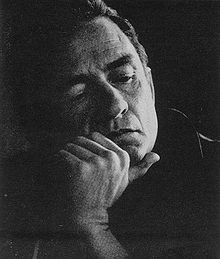 On this day in 2003, legendary county music singer and songwriter, member of The Highwaymen, the Man in Black, Johnny Cash died at the age of 71 at Baptist Hospital in Nashville from complications from diabetes. Born J. R. Cash on 26 February 1932 in Kingsland, Arkansas. In my opinion, one of the most influential musicians of the 20th century. His songs and sound spanned genres from rock and roll and rockabilly to country, blues, folk, and gospel. This crossover appeal won Cash the rare honor of induction in the Country Music Hall of Fame, the Rock and Roll Hall of Fame, and the Gospel Music Hall of Fame. Cash was known for his deep, distinctive bass-baritone voice; a rebelliousness, coupled with an increasingly somber and humble demeanor; for providing free concerts inside prison walls; and for his dark performance clothing, which earned him the nickname “The Man in Black”. He traditionally began his concerts with the phrase “Hello, I’m Johnny Cash,” followed by his standard “Folsom Prison Blues”. Much of Cash’s music echoed themes of sorrow, moral tribulation and redemption, especially in the later stages of his career. His best-known songs included “I Walk the Line”, “Folsom Prison Blues”, “Ring of Fire”, “Get Rhythm”, “Man in Black”, “One Piece at a Time” and “A Boy Named Sue”; a duet with his future wife, June Carter, called “Jackson”; and railroad songs including “Hey, Porter” and “Rock Island Line”. The supergroup The Highwaymen included Cash, Willie Nelson, Waylon Jennings and Kris Kristofferson.
On this day in 2003, legendary county music singer and songwriter, member of The Highwaymen, the Man in Black, Johnny Cash died at the age of 71 at Baptist Hospital in Nashville from complications from diabetes. Born J. R. Cash on 26 February 1932 in Kingsland, Arkansas. In my opinion, one of the most influential musicians of the 20th century. His songs and sound spanned genres from rock and roll and rockabilly to country, blues, folk, and gospel. This crossover appeal won Cash the rare honor of induction in the Country Music Hall of Fame, the Rock and Roll Hall of Fame, and the Gospel Music Hall of Fame. Cash was known for his deep, distinctive bass-baritone voice; a rebelliousness, coupled with an increasingly somber and humble demeanor; for providing free concerts inside prison walls; and for his dark performance clothing, which earned him the nickname “The Man in Black”. He traditionally began his concerts with the phrase “Hello, I’m Johnny Cash,” followed by his standard “Folsom Prison Blues”. Much of Cash’s music echoed themes of sorrow, moral tribulation and redemption, especially in the later stages of his career. His best-known songs included “I Walk the Line”, “Folsom Prison Blues”, “Ring of Fire”, “Get Rhythm”, “Man in Black”, “One Piece at a Time” and “A Boy Named Sue”; a duet with his future wife, June Carter, called “Jackson”; and railroad songs including “Hey, Porter” and “Rock Island Line”. The supergroup The Highwaymen included Cash, Willie Nelson, Waylon Jennings and Kris Kristofferson.
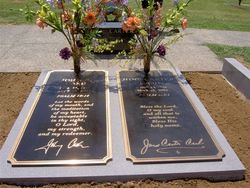
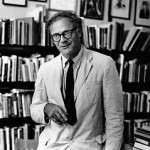 On this day in 1977, poet, 2x Pulitzer Prize recipient, Robert Lowell died having suffered a heart attack in a cab in New York City on his way to see his ex-wife, Elizabeth Hardwick, at the age of 60. Born Robert Traill Spence Lowell IV on 1 March 1917 into a Boston Brahmin family. Lowell stated, “The poets who most directly influenced me … were Allen Tate, Elizabeth Bishop, and William Carlos Williams. An unlikely combination!….. but you can see that Bishop is a sort of bridge between Tate’s formalism and Williams’s informal art.” After the publication of his 1959 book Life Studies, which won the 1960 National Book Award, which featured uninhibited discussions of personal, family, and psychological struggles, he was considered an important part of the confessional poetry movement. Lowell worked in a number of distinctive stylistic modes and forms over the course of his career. He was appointed the sixth Poet Laureate Consultant in Poetry to the Library of Congress, where he served from 1947 until 1948. In addition to winning the National Book Award, he won the Pulitzer Prize for Poetry in 1947 and 1974, the National Book Critics Circle Award in 1977, and a National Institute of Arts and Letters Award in 1947. In my opinion, he is one of the most important American poets of the postwar era. His biographer Paul Mariani called him “the poet-historian of our time” and “the last of [America’s] influential public poets.” Lowell married three times: Jean Stafford (1940 – 1948 divorce), Hardwick (1949 – 1972 divorce) and Caroline Blackwood (1972 – 1977 his death).
On this day in 1977, poet, 2x Pulitzer Prize recipient, Robert Lowell died having suffered a heart attack in a cab in New York City on his way to see his ex-wife, Elizabeth Hardwick, at the age of 60. Born Robert Traill Spence Lowell IV on 1 March 1917 into a Boston Brahmin family. Lowell stated, “The poets who most directly influenced me … were Allen Tate, Elizabeth Bishop, and William Carlos Williams. An unlikely combination!….. but you can see that Bishop is a sort of bridge between Tate’s formalism and Williams’s informal art.” After the publication of his 1959 book Life Studies, which won the 1960 National Book Award, which featured uninhibited discussions of personal, family, and psychological struggles, he was considered an important part of the confessional poetry movement. Lowell worked in a number of distinctive stylistic modes and forms over the course of his career. He was appointed the sixth Poet Laureate Consultant in Poetry to the Library of Congress, where he served from 1947 until 1948. In addition to winning the National Book Award, he won the Pulitzer Prize for Poetry in 1947 and 1974, the National Book Critics Circle Award in 1977, and a National Institute of Arts and Letters Award in 1947. In my opinion, he is one of the most important American poets of the postwar era. His biographer Paul Mariani called him “the poet-historian of our time” and “the last of [America’s] influential public poets.” Lowell married three times: Jean Stafford (1940 – 1948 divorce), Hardwick (1949 – 1972 divorce) and Caroline Blackwood (1972 – 1977 his death).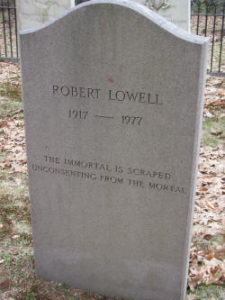 Final Footprint – Lowell is buried in Stark Cemetery, Dunbarton, New Hampshire.
Final Footprint – Lowell is buried in Stark Cemetery, Dunbarton, New Hampshire.  On this day in 1992, actor and singer Anthony Perkins died from AIDS related pneumonia in his Los Angeles home at the age of 60. Born April 4, 1932 in New York City. He was nominated for the Academy Award for Best Supporting Actor for his second film, Friendly Persuasion, but is best known for playing Norman Bates in Alfred Hitchcock’s Psycho (1960) and its three sequels. His other films include Fear Strikes Out (1957), The Matchmaker (1958), On the Beach (1959), Tall Story (1960), The Trial (1962), Phaedra (1962), Five Miles to Midnight (1962), Pretty Poison (1968), Murder on the Orient Express (1974), Mahogany (1975), North Sea Hijack (1979), The Black Hole (1979), and Crimes of Passion (1984).
On this day in 1992, actor and singer Anthony Perkins died from AIDS related pneumonia in his Los Angeles home at the age of 60. Born April 4, 1932 in New York City. He was nominated for the Academy Award for Best Supporting Actor for his second film, Friendly Persuasion, but is best known for playing Norman Bates in Alfred Hitchcock’s Psycho (1960) and its three sequels. His other films include Fear Strikes Out (1957), The Matchmaker (1958), On the Beach (1959), Tall Story (1960), The Trial (1962), Phaedra (1962), Five Miles to Midnight (1962), Pretty Poison (1968), Murder on the Orient Express (1974), Mahogany (1975), North Sea Hijack (1979), The Black Hole (1979), and Crimes of Passion (1984).

 On this day in 1994, stage and screen actress Jessica Tandy died at her home in Easton, Connecticut, at the age of 85. Born Jessie Alice Tandy on 7 June 1909 in Hackney, London. Tandy appeared in over 100 stage productions and had more than 60 roles in film and TV, receiving an Academy Award, four Tony Awards, a BAFTA, a Golden Globe Award, and a Primetime Emmy Award. She acted as Blanche DuBois in the original Broadway production of A Streetcar Named Desire in 1948. Her films included Alfred Hitchcock’s The Birds and The Gin Game. At 80, she became the oldest actress to receive the Academy Award for Best Actress for her role in Driving Miss Daisy.
On this day in 1994, stage and screen actress Jessica Tandy died at her home in Easton, Connecticut, at the age of 85. Born Jessie Alice Tandy on 7 June 1909 in Hackney, London. Tandy appeared in over 100 stage productions and had more than 60 roles in film and TV, receiving an Academy Award, four Tony Awards, a BAFTA, a Golden Globe Award, and a Primetime Emmy Award. She acted as Blanche DuBois in the original Broadway production of A Streetcar Named Desire in 1948. Her films included Alfred Hitchcock’s The Birds and The Gin Game. At 80, she became the oldest actress to receive the Academy Award for Best Actress for her role in Driving Miss Daisy. oday is Patriot Day and National Day of Service and Remembrance, designated in memory of the 2,977 killed in the September 11, 2001 terrorist attacks. A total of 411 emergency workers died as they tried to rescue people and fight fires. The New York City Fire Department (FDNY) lost 340 firefighters, a chaplain and two paramedics. The New York City Police Department (NYPD) lost 23 officers. The Port Authority Police Department lost 37 officers. Eight emergency medical technicians (EMTs) and paramedics from private emergency medical services units were killed.
oday is Patriot Day and National Day of Service and Remembrance, designated in memory of the 2,977 killed in the September 11, 2001 terrorist attacks. A total of 411 emergency workers died as they tried to rescue people and fight fires. The New York City Fire Department (FDNY) lost 340 firefighters, a chaplain and two paramedics. The New York City Police Department (NYPD) lost 23 officers. The Port Authority Police Department lost 37 officers. Eight emergency medical technicians (EMTs) and paramedics from private emergency medical services units were killed. One of the first memorials was the Tribute in Light, an installation of 88 searchlights at the footprints of the World Trade Center towers. In New York, the World Trade Center Site Memorial Competition was held to design an appropriate memorial on the site. The winning design, Reflecting Absence, was selected in August 2006, and consists of a pair of reflecting pools in the footprints of the towers, surrounded by a list of the victims’ names in an underground memorial space.
One of the first memorials was the Tribute in Light, an installation of 88 searchlights at the footprints of the World Trade Center towers. In New York, the World Trade Center Site Memorial Competition was held to design an appropriate memorial on the site. The winning design, Reflecting Absence, was selected in August 2006, and consists of a pair of reflecting pools in the footprints of the towers, surrounded by a list of the victims’ names in an underground memorial space. The Pentagon Memorial was completed and opened to the public on the seventh anniversary of the attacks in 2008. It consists of a landscaped park with 184 benches facing the Pentagon. When the Pentagon was repaired in 2001–2002, a private chapel and indoor memorial were included, located at the spot where Flight 77 crashed into the building.
The Pentagon Memorial was completed and opened to the public on the seventh anniversary of the attacks in 2008. It consists of a landscaped park with 184 benches facing the Pentagon. When the Pentagon was repaired in 2001–2002, a private chapel and indoor memorial were included, located at the spot where Flight 77 crashed into the building. The Flight 93 National Memorial is located at the site of the crash of United Airlines Flight 93, which was hijacked in the September 11 attacks, in Stonycreek Township, Pennsylvania, about 2 miles (3.2 km) north of Shanksville, and 60 miles (97 km) southeast of Pittsburgh. The memorial was made to honor the passengers and crew of Flight 93, who stopped the terrorists from reaching their target. A temporary memorial to the 40 victims was established soon after the crash, and the first phase of the permanent memorial was completed, opened, and dedicated on September 10, 2011. The current design for the memorial is a modified version of the entry Crescent of Embrace by Paul and Milena Murdoch. It was added to the National Register of Historic Places in 2012.
The Flight 93 National Memorial is located at the site of the crash of United Airlines Flight 93, which was hijacked in the September 11 attacks, in Stonycreek Township, Pennsylvania, about 2 miles (3.2 km) north of Shanksville, and 60 miles (97 km) southeast of Pittsburgh. The memorial was made to honor the passengers and crew of Flight 93, who stopped the terrorists from reaching their target. A temporary memorial to the 40 victims was established soon after the crash, and the first phase of the permanent memorial was completed, opened, and dedicated on September 10, 2011. The current design for the memorial is a modified version of the entry Crescent of Embrace by Paul and Milena Murdoch. It was added to the National Register of Historic Places in 2012.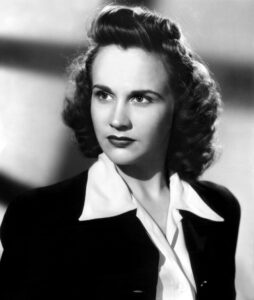 And on this day in 2002, stage and film actress Kim Hunter died in New York City of a heart attack at the age of 79. Born Janet Cole on November 12, 1922 in Detroit. She achieved prominence for portraying Stella Kowalski in the original production of Tennessee Williams’ A Streetcar Named Desire, which she reprised for the 1951 film adaptation, and won both an Academy Award and a Golden Globe Award for Best Supporting Actress. Decades later, she was nominated for a Daytime Emmy Award for her work on the soap opera The Edge of Night. She also portrayed the chimpanzee Zira in Planet of the Apes (1968), and its sequels Beneath the Planet of the Apes (1970) and Escape from the Planet of the Apes (1971).
And on this day in 2002, stage and film actress Kim Hunter died in New York City of a heart attack at the age of 79. Born Janet Cole on November 12, 1922 in Detroit. She achieved prominence for portraying Stella Kowalski in the original production of Tennessee Williams’ A Streetcar Named Desire, which she reprised for the 1951 film adaptation, and won both an Academy Award and a Golden Globe Award for Best Supporting Actress. Decades later, she was nominated for a Daytime Emmy Award for her work on the soap opera The Edge of Night. She also portrayed the chimpanzee Zira in Planet of the Apes (1968), and its sequels Beneath the Planet of the Apes (1970) and Escape from the Planet of the Apes (1971). On this day in 1827, writer, revolutionary and poet Ugo Foscolo died at Turnham Green, England, at the age of 49. Born Niccolò Ugo Foscolo on the Ionian island of Zakynthos, Republic of Venice, on 6 February 1778. Perhaps best known for his 1807 long poem Dei Sepolcri, which may be described as an effort to seek refuge in the past from the misery of the present and the darkness of the future.
On this day in 1827, writer, revolutionary and poet Ugo Foscolo died at Turnham Green, England, at the age of 49. Born Niccolò Ugo Foscolo on the Ionian island of Zakynthos, Republic of Venice, on 6 February 1778. Perhaps best known for his 1807 long poem Dei Sepolcri, which may be described as an effort to seek refuge in the past from the misery of the present and the darkness of the future. The Final Footprint – Foscolo was entombed in Old Chiswick Cemetery, in Chiswick, England. Forty-four years after his death, on 7 June 1871, his remains were brought to Florence, and with all the pride, pomp and circumstance of a great national mourning, found their final resting-place beside the monuments of Machiavelli and Alfieri, of Michelangelo and Galileo, in the church of Santa Croce, the pantheon of Italian glory he had celebrated in Dei sepolcri. His tomb in the cemetery of St. Nicholas parish church, Chiswick, in West London has recently been restored, it refers to him as the “wearied citizen poet” and incorrectly states his age as 50.
The Final Footprint – Foscolo was entombed in Old Chiswick Cemetery, in Chiswick, England. Forty-four years after his death, on 7 June 1871, his remains were brought to Florence, and with all the pride, pomp and circumstance of a great national mourning, found their final resting-place beside the monuments of Machiavelli and Alfieri, of Michelangelo and Galileo, in the church of Santa Croce, the pantheon of Italian glory he had celebrated in Dei sepolcri. His tomb in the cemetery of St. Nicholas parish church, Chiswick, in West London has recently been restored, it refers to him as the “wearied citizen poet” and incorrectly states his age as 50. On this day in 1931, Sicilian organized crime figure, early Cosa Nostra boss in the United States, capo di tutti capi, boss of bosses, Salvatore Maranzano died inside his office on the 9th floor of The Helmsley Building in Midtown Manhattan, from multiple gunshot and stab wounds, at the age of 45. Born on 31 July 1886 in Castellammare del Golfo, Sicily. He instigated the Castellammarese War to seize control of the American Mafia operations, and briefly became the Mafia’s “Boss of Bosses”. He was assassinated by a younger faction led by Lucky Luciano, who established a power-sharing arrangement rather than a “boss of bosses” to prevent future wars.
On this day in 1931, Sicilian organized crime figure, early Cosa Nostra boss in the United States, capo di tutti capi, boss of bosses, Salvatore Maranzano died inside his office on the 9th floor of The Helmsley Building in Midtown Manhattan, from multiple gunshot and stab wounds, at the age of 45. Born on 31 July 1886 in Castellammare del Golfo, Sicily. He instigated the Castellammarese War to seize control of the American Mafia operations, and briefly became the Mafia’s “Boss of Bosses”. He was assassinated by a younger faction led by Lucky Luciano, who established a power-sharing arrangement rather than a “boss of bosses” to prevent future wars. The Final Footprint – Maranzano and his wife Elisabetta (who died in 1964) are buried in Saint John’s Cemetery, Queens, located in New York City. Maranzano plays a small fictionalized role in Mario Puzo’s The Godfather. Maranzano refused Don Vito Corleone’s proposal to share his monopoly on gambling in New York City, in exchange for police and political contacts and expansion into Brooklyn and the Bronx. Maranzano arranged for two of Al Capone’s gunmen to come to New York and finish Corleone. Through his contacts in Chicago, Corleone found out, and sent Luca Brasi to murder the gunmen. With Capone out of the picture, the great mob war of 1933 had begun. Desperate for peace, Maranzano agreed to a sit down in a restaurant in Brooklyn, where he was killed by Salvatore Tessio and his men. Afterwards, Corleone called a meeting to reorganize the American Mafia, something that the real life Maranzano did. Other notable, and infamous, final footprints at Saint John’s include Joe Colombo, Carlo Gambino, John Gotti, Luciano, and Vito Genovese.
The Final Footprint – Maranzano and his wife Elisabetta (who died in 1964) are buried in Saint John’s Cemetery, Queens, located in New York City. Maranzano plays a small fictionalized role in Mario Puzo’s The Godfather. Maranzano refused Don Vito Corleone’s proposal to share his monopoly on gambling in New York City, in exchange for police and political contacts and expansion into Brooklyn and the Bronx. Maranzano arranged for two of Al Capone’s gunmen to come to New York and finish Corleone. Through his contacts in Chicago, Corleone found out, and sent Luca Brasi to murder the gunmen. With Capone out of the picture, the great mob war of 1933 had begun. Desperate for peace, Maranzano agreed to a sit down in a restaurant in Brooklyn, where he was killed by Salvatore Tessio and his men. Afterwards, Corleone called a meeting to reorganize the American Mafia, something that the real life Maranzano did. Other notable, and infamous, final footprints at Saint John’s include Joe Colombo, Carlo Gambino, John Gotti, Luciano, and Vito Genovese. On this day in 1935, the 40th Governor of Louisiana, United States Senator, The Kingfish, Huey Long died from gunshot wounds he sustained at the Louisiana State Capitol building in Baton Rouge during a confrontation with Dr. Carl Weiss. Born Huey Pierce Long, Jr. 0n 30 August 1893 in Winnfield, Louisiana. A Democrat, he was an outspoken populist, partially inspired by sansepolcrista Italian fascism. During his tenure, he commanded large networks of supporters and was willing to take forceful action, influencing claims that he was a political boss. He established the political prominence of the Long political family. Long is best known for his Share Our Wealth program, created in 1934 under the motto “Every Man a King.” It proposed new wealth redistribution measures in the form of a net asset tax on corporations and individuals to curb the poverty and homelessness endemic nationwide during the Great Depression. To stimulate the economy, Long advocated federal spending on public works, schools and colleges, and old age pensions. He was an ardent critic of the policies of the Federal Reserve System. A supporter of Franklin D. Roosevelt in the 1932 presidential election, Long split with Roosevelt in June 1933 to plan his own presidential bid for 1936 in alliance with the influential Catholic priest and radio commentator Charles Coughlin. Under Long’s leadership, hospitals and educational institutions were expanded, a system of charity hospitals was set up that provided health care for the poor, massive highway construction and free bridges brought an end to rural isolationism, and free textbooks for schoolchildren were introduced to tackle illiteracy.
On this day in 1935, the 40th Governor of Louisiana, United States Senator, The Kingfish, Huey Long died from gunshot wounds he sustained at the Louisiana State Capitol building in Baton Rouge during a confrontation with Dr. Carl Weiss. Born Huey Pierce Long, Jr. 0n 30 August 1893 in Winnfield, Louisiana. A Democrat, he was an outspoken populist, partially inspired by sansepolcrista Italian fascism. During his tenure, he commanded large networks of supporters and was willing to take forceful action, influencing claims that he was a political boss. He established the political prominence of the Long political family. Long is best known for his Share Our Wealth program, created in 1934 under the motto “Every Man a King.” It proposed new wealth redistribution measures in the form of a net asset tax on corporations and individuals to curb the poverty and homelessness endemic nationwide during the Great Depression. To stimulate the economy, Long advocated federal spending on public works, schools and colleges, and old age pensions. He was an ardent critic of the policies of the Federal Reserve System. A supporter of Franklin D. Roosevelt in the 1932 presidential election, Long split with Roosevelt in June 1933 to plan his own presidential bid for 1936 in alliance with the influential Catholic priest and radio commentator Charles Coughlin. Under Long’s leadership, hospitals and educational institutions were expanded, a system of charity hospitals was set up that provided health care for the poor, massive highway construction and free bridges brought an end to rural isolationism, and free textbooks for schoolchildren were introduced to tackle illiteracy. The Final Footprint – Long’s body was dressed in a tuxedo and his open double casket (made of bronze with a copper inner liner covered with a glass lid) was placed in the State Capitol rotunda. An estimated 200,000 people flooded Baton Rouge to witness the event. Tens of thousands of Louisianans crowded in front of the Capitol on September 12, 1935, for the 4 p.m. funeral handled by Merle Welsh of Rabenhorst Funeral Home. Welsh remembered that flowers came from all over the world and extended from the House of Representatives to the Senate chamber. Airline Highway between New Orleans and Baton Rouge was jammed bumper-to-bumper. Newsreel cameras clicked while airplanes circled overhead to record the service for posterity. Long was buried on the grounds of the State Capitol in Baton Rouge. A large bronze statue on top of a marble column marks the site of his grave. A plaque marks the site of the assassination inside the capitol. Also, a bronze statue of Long is located in Statuary Hall of the U. S. Capitol. Long’s assassination put an end to his national movement, but his legacy continued in Louisiana through his wife, Senator Rose McConnell Long, and his son, Senator Russell B. Long. The character Willie Stark from the novel All the King’s Men by Robert Penn Warren appears to be loosely based on Long. This is perhaps my all time favorite book. The book has inspired two movies; the Oscar-winning 1949 version and a 2006 version starring Sean Penn.
The Final Footprint – Long’s body was dressed in a tuxedo and his open double casket (made of bronze with a copper inner liner covered with a glass lid) was placed in the State Capitol rotunda. An estimated 200,000 people flooded Baton Rouge to witness the event. Tens of thousands of Louisianans crowded in front of the Capitol on September 12, 1935, for the 4 p.m. funeral handled by Merle Welsh of Rabenhorst Funeral Home. Welsh remembered that flowers came from all over the world and extended from the House of Representatives to the Senate chamber. Airline Highway between New Orleans and Baton Rouge was jammed bumper-to-bumper. Newsreel cameras clicked while airplanes circled overhead to record the service for posterity. Long was buried on the grounds of the State Capitol in Baton Rouge. A large bronze statue on top of a marble column marks the site of his grave. A plaque marks the site of the assassination inside the capitol. Also, a bronze statue of Long is located in Statuary Hall of the U. S. Capitol. Long’s assassination put an end to his national movement, but his legacy continued in Louisiana through his wife, Senator Rose McConnell Long, and his son, Senator Russell B. Long. The character Willie Stark from the novel All the King’s Men by Robert Penn Warren appears to be loosely based on Long. This is perhaps my all time favorite book. The book has inspired two movies; the Oscar-winning 1949 version and a 2006 version starring Sean Penn. On this day in 1971, singer, model, actress Pier Angeli died of a barbiturate overdose at her home in Beverly Hills, aged 39. Born Anna Maria Pierangeli on 19 June 1932 in Cagliari, Sardinia, Italy. She starred in American, British and European films throughout her career. Her American motion picture debut was in the starring role of the film Teresa (1951), for which she won a Golden Globe Award for Young Star of the Year – Actress.
On this day in 1971, singer, model, actress Pier Angeli died of a barbiturate overdose at her home in Beverly Hills, aged 39. Born Anna Maria Pierangeli on 19 June 1932 in Cagliari, Sardinia, Italy. She starred in American, British and European films throughout her career. Her American motion picture debut was in the starring role of the film Teresa (1951), for which she won a Golden Globe Award for Young Star of the Year – Actress. The Final Footprint – On the day of her death, Angeli had been given an injection of Compazine by her doctor. Death due to anaphylaxis has been suggested; however, it is not supported by the findings of her autopsy. Her former lover Kirk Douglas and his wife Anne Buydens were among those who were invited to her funeral. She is interred in the Cimetière des Bulvis in Rueil-Malmaison, Hauts-de-Seine, France.
The Final Footprint – On the day of her death, Angeli had been given an injection of Compazine by her doctor. Death due to anaphylaxis has been suggested; however, it is not supported by the findings of her autopsy. Her former lover Kirk Douglas and his wife Anne Buydens were among those who were invited to her funeral. She is interred in the Cimetière des Bulvis in Rueil-Malmaison, Hauts-de-Seine, France. On this day in 1976, screenwriter Dalton Trumbo died in Los Angeles of a heart attack at the age of 70. Born James Dalton Trumbo on December 9, 1905 in Montrose, Colorado. He scripted many award-winning films, including Roman Holiday (1953), Exodus, Spartacus (both 1960), and Thirty Seconds Over Tokyo (1944). One of the Hollywood Ten, he refused to testify before the House Un-American Activities Committee (HUAC) in 1947 during the committee’s investigation of alleged Communist influences in the motion picture industry. Trumbo, the other members of the Hollywood Ten, and hundreds of other professionals in the industry were blacklisted by Hollywood. He was able to continue working clandestinely on major films, writing under pseudonyms or other authors’ names. His uncredited work won two Academy Awards for Best Story: for Roman Holiday (1953), which was presented to a front writer, and for The Brave One (1956), which was awarded to a pseudonym used by Trumbo. When he was given public screen credit for both Exodus and Spartacus in 1960, it marked the beginning of the end of the Hollywood Blacklist for Trumbo and other affected screenwriters. He finally was given full credit by the Writers’ Guild for Roman Holiday in 2011, nearly 60 years after the fact.
On this day in 1976, screenwriter Dalton Trumbo died in Los Angeles of a heart attack at the age of 70. Born James Dalton Trumbo on December 9, 1905 in Montrose, Colorado. He scripted many award-winning films, including Roman Holiday (1953), Exodus, Spartacus (both 1960), and Thirty Seconds Over Tokyo (1944). One of the Hollywood Ten, he refused to testify before the House Un-American Activities Committee (HUAC) in 1947 during the committee’s investigation of alleged Communist influences in the motion picture industry. Trumbo, the other members of the Hollywood Ten, and hundreds of other professionals in the industry were blacklisted by Hollywood. He was able to continue working clandestinely on major films, writing under pseudonyms or other authors’ names. His uncredited work won two Academy Awards for Best Story: for Roman Holiday (1953), which was presented to a front writer, and for The Brave One (1956), which was awarded to a pseudonym used by Trumbo. When he was given public screen credit for both Exodus and Spartacus in 1960, it marked the beginning of the end of the Hollywood Blacklist for Trumbo and other affected screenwriters. He finally was given full credit by the Writers’ Guild for Roman Holiday in 2011, nearly 60 years after the fact. On this day in 2005, musician, singer Clarence “Gatemouth” Brown died in Orange, Texas at the apartment of a grandniece, at the age of 81. Born on April 18, 1924 in Vinton, Louisiana. He won a Grammy Award for Best Traditional Blues Album in 1983 for his album, Alright Again!.
On this day in 2005, musician, singer Clarence “Gatemouth” Brown died in Orange, Texas at the apartment of a grandniece, at the age of 81. Born on April 18, 1924 in Vinton, Louisiana. He won a Grammy Award for Best Traditional Blues Album in 1983 for his album, Alright Again!. The Final Footprint – Brown is buried in the Hollywood Cemetery in Orange. Flooding caused by Hurricane Ike in September 2008 damaged his grave. His grave has since been refurbished and through the estate funds, a headstone has been erected in his honor. A marker honoring Brown was placed by the Texas Historical Commission next to the flagpole at Hollywood Cemetery.
The Final Footprint – Brown is buried in the Hollywood Cemetery in Orange. Flooding caused by Hurricane Ike in September 2008 damaged his grave. His grave has since been refurbished and through the estate funds, a headstone has been erected in his honor. A marker honoring Brown was placed by the Texas Historical Commission next to the flagpole at Hollywood Cemetery. On this day in 2014, actor Richard Kiel died from a heart attack
On this day in 2014, actor Richard Kiel died from a heart attack  The Final Footprint
The Final Footprint On this day in 2020 actress (The Avengers, On Her Majesty’s Secret Service, Game of Thrones) Diana Rigg died from lung cancer at her London home, aged 82. Her roles include Emma Peel in the TV series The Avengers (1965–1968); Countess Teresa di Vicenzo, wife of James Bond, in On Her Majesty’s Secret Service (1969); Olenna Tyrell in Game of Thrones (2013–2017); and the title role in Medea in the West End in 1993 followed by Broadway a year later.
On this day in 2020 actress (The Avengers, On Her Majesty’s Secret Service, Game of Thrones) Diana Rigg died from lung cancer at her London home, aged 82. Her roles include Emma Peel in the TV series The Avengers (1965–1968); Countess Teresa di Vicenzo, wife of James Bond, in On Her Majesty’s Secret Service (1969); Olenna Tyrell in Game of Thrones (2013–2017); and the title role in Medea in the West End in 1993 followed by Broadway a year later.